Wander in silence. Wonder along the way.
photography
Framed by the Trees
Our journey took us off the beaten path today as we climbed over a snowbank at the end of Farrington Pond Road and onto the Greater Lovell Land Trust’s John A. Segur Wildlife Refuge East. We began at a piece of the parcel neither Pam Marshall or I had ever explored before, which added to the fun. At first, we followed the tracks of a giant, and eventually decided they might have belonged to another human being. Might have. Always wonder.

And then we were stopped in our tracks as we looked up and recognized a Great Blue Heron–or so it seemed in the dead snag that towered over the edge of Farrington Pond. Except for one tiny area of water, the pond is still very much ice covered so it will be a while before this ancestor of the Greats sees her relatives return.

Standing beside the bird-like structure was another that helped us find beauty and life in death.

We peered in, and down, and up, and all around. With each glance, our understandings increased. So did our questions.

There were holes that became windows looking out to the forest beyond.

But those same windows helped us realize they were framed by the results of their injuries. You see, it appeared that a pileated woodpecker had dined on the many insects who had mined the inner workings of the tree. After being so wounded by the birds, the tree attempted to heal its scars as evidenced by the thick growth ring structure that surrounded each hole. Or at least, that’s what we think happened.

To back up our story, we looked from the outside in and saw the same.
We also noted the corky bark with its diamond shapes formed where one chunk met another.

And much to our surprise, we found one compound leaf still dangling. No, this is not a marcescent tree, one of those known to hold its withering leaves to the end of time (or beginning of the next leaf year). But instead, this old sage is one of the first to drop its leaves. So why did one outlast the race? Perhaps to provide a lesson about leaves and leaflets, the latter being the components of the compound structure.

Adding to the identification, we realized we were treated to several saplings growing at the base of the one dying above. By its bud shape and opposite orientation we named it Ash. By its notched leaf scars and lack of hairs, we named it White. White Ash.

Because we were looking, Pam also found a sign of life within. We suspected a caterpillar had taken advantage of the sheltered location, but didn’t know which one.
About simultaneously, our research once we arrived at our respective homes, suggested a hickory tussock moth. Can you see the black setae within the hair?
Pam took the research one step further and sent this: “I read that the female lays eggs on top of the cocoon and then makes a kind of foam that hardens over them so they can survive the winter. How cool is that?” Wicked Cool, Indeed!

We probably spent close to an hour with that tree, getting to know it from every possible angle.

And then it was time to stop looking through the window and to instead step into the great beyond.
We did just that, and found another set of mammal tracks to follow. Tracking conditions were hardly ideal and we followed the set for a long way, never quite deciding if it was a fisher or a bobcat, or one animal traveling one way and another the opposite but within the same path.

Eventually, we gave up on the shifty mammal and made our way into the upland portion of the property where I knew a bear claw tree stood. Pam’s task was to locate it and so she set off, checking all the beech trees in the forest.
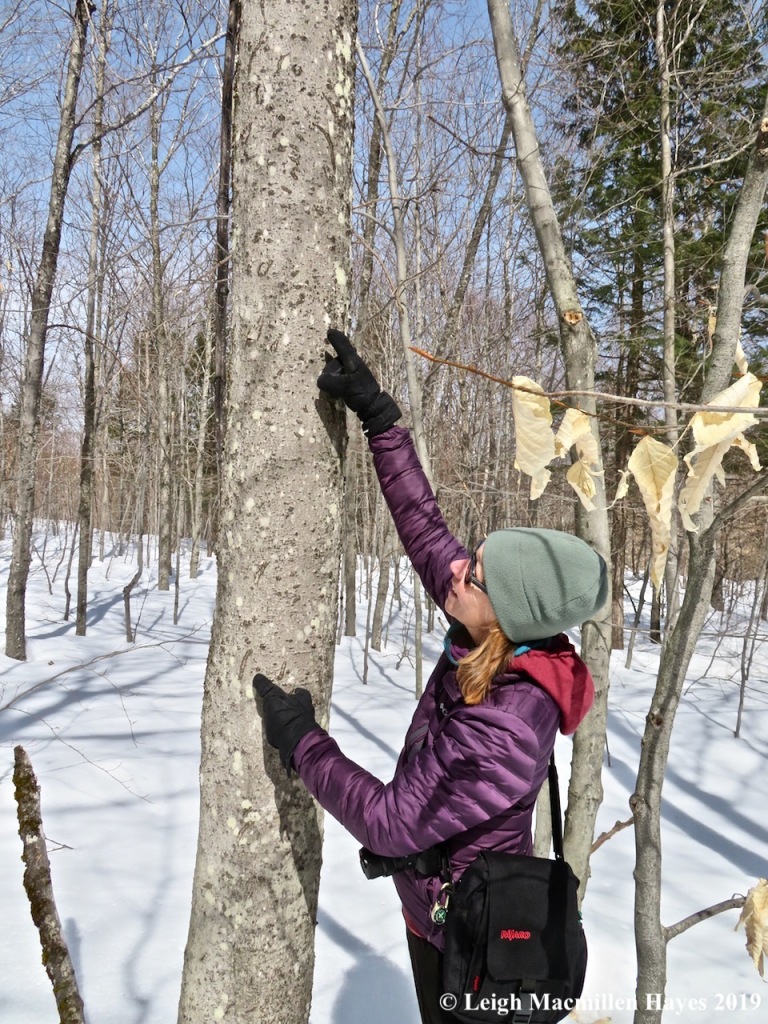
Bingo! Her bear paw tree eyes were formed.

It was a beauty of a specimen that reminded us of all the wonders of this place.

From that tree, we continued off-trail, zigzagging from tree to tree, but never found another. That doesn’t mean we visited every tree in the refuge and so we’ll just have to return and look some more.
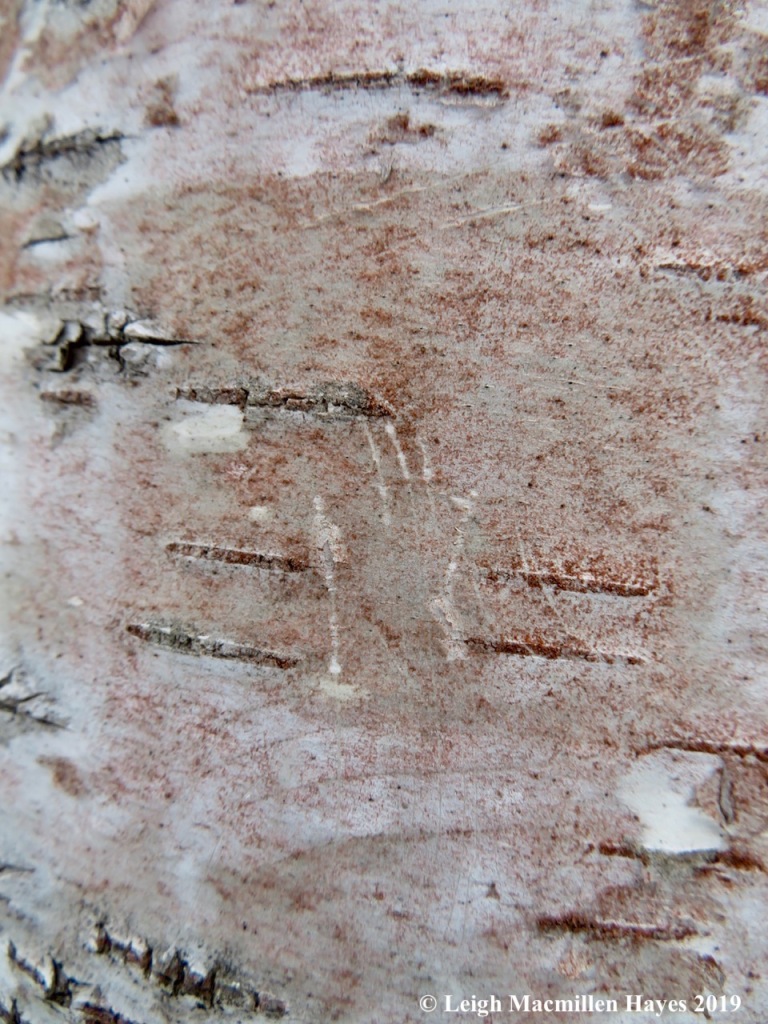
We did, however, find some scratch marks on a paper birch.
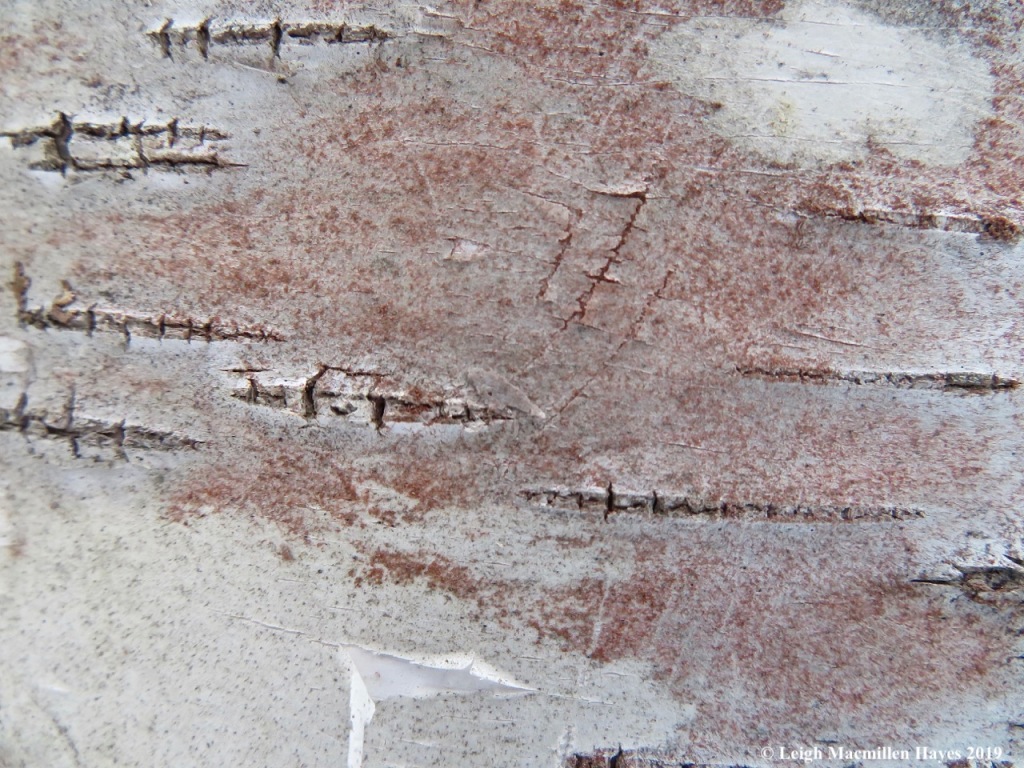
They were too close together to have been created by even a young bear, but we did consider squirrel. Wiping off the rosy-white chalk that coated the bark, we did find actual scrapes below. Now we’ll have to remember to check that tree again in a year or so and see what we might see.

What we finally saw before making our best bee-line out (don’t worry, our Nature Distraction Disorder still slowed us down) was the view of Sucker Brook and the mountains beyond.

At last we pulled ourselves away, but gave great thanks for that ash tree that framed our day and our focus and for all that we saw within it and beyond.
Book of February: Ferdinand Fox’s First Summer
Yikes. Here it is the end of February and I’ve spent the month mentally flipflopping between two books to recommend–one about tracks and the other about tree buds.
And then this day dawned. Not long into the morning as I sat at my desk beside a window, a swift motion captured my attention . . .

and I knew immediately that Ferdinand Fox’s First Summer by Mary Holland would be the February Book of the Month.
In this factual, yet delightful story, Mary tells of Ferdinand’s birth, childhood activities, and growth as he and his siblings are born and eventually weaned. Her amazing photographs fill the pages and alone are worth a reason to purchase this book. But there’s so much more and one doesn’t need to be 3-8 years old to enjoy it. Even those of us who are more “mature” can surely learn from the information shared on each of the book’s 32 pages.
And there’s even more to the book because at the end is a section her publisher labels “For Creative Minds.” Though one can’t copy other pages in the book, we are encouraged to use the material in this section for educational, non-commercial purposes.
Included are “Red Fox Fun Facts and Adaptations” with photographs and brief blurbs to describe various behaviors of these canines. (I remember a time when I had to get it through my brain that a fox was a canine and not a feline.)
One of my favorites from this section: “Red foxes are most active at dusk and dawn (crepuscular). In summer, they are more active at night (nocturnal) because their prey, mice, are more active then. Foxes may hunt during the day (diurnal) in the winter because it’s harder to find food.”
Bingo! That brings me to the reason why I chose this book for February.
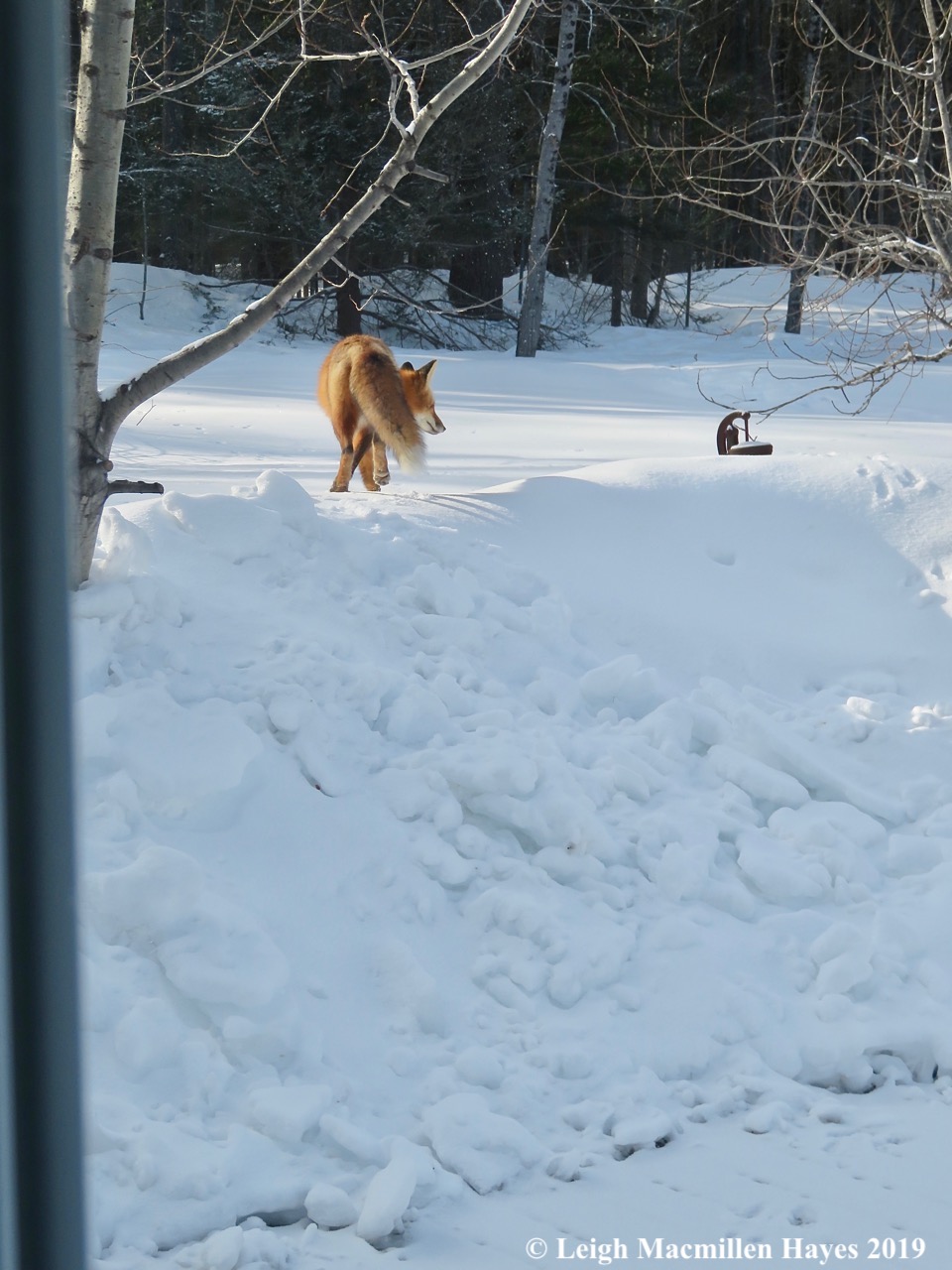
Remember that motion I mentioned observing this morning. Well, I went to the kitchen door and there on the snowbank by the back deck was my neighborhood fox.
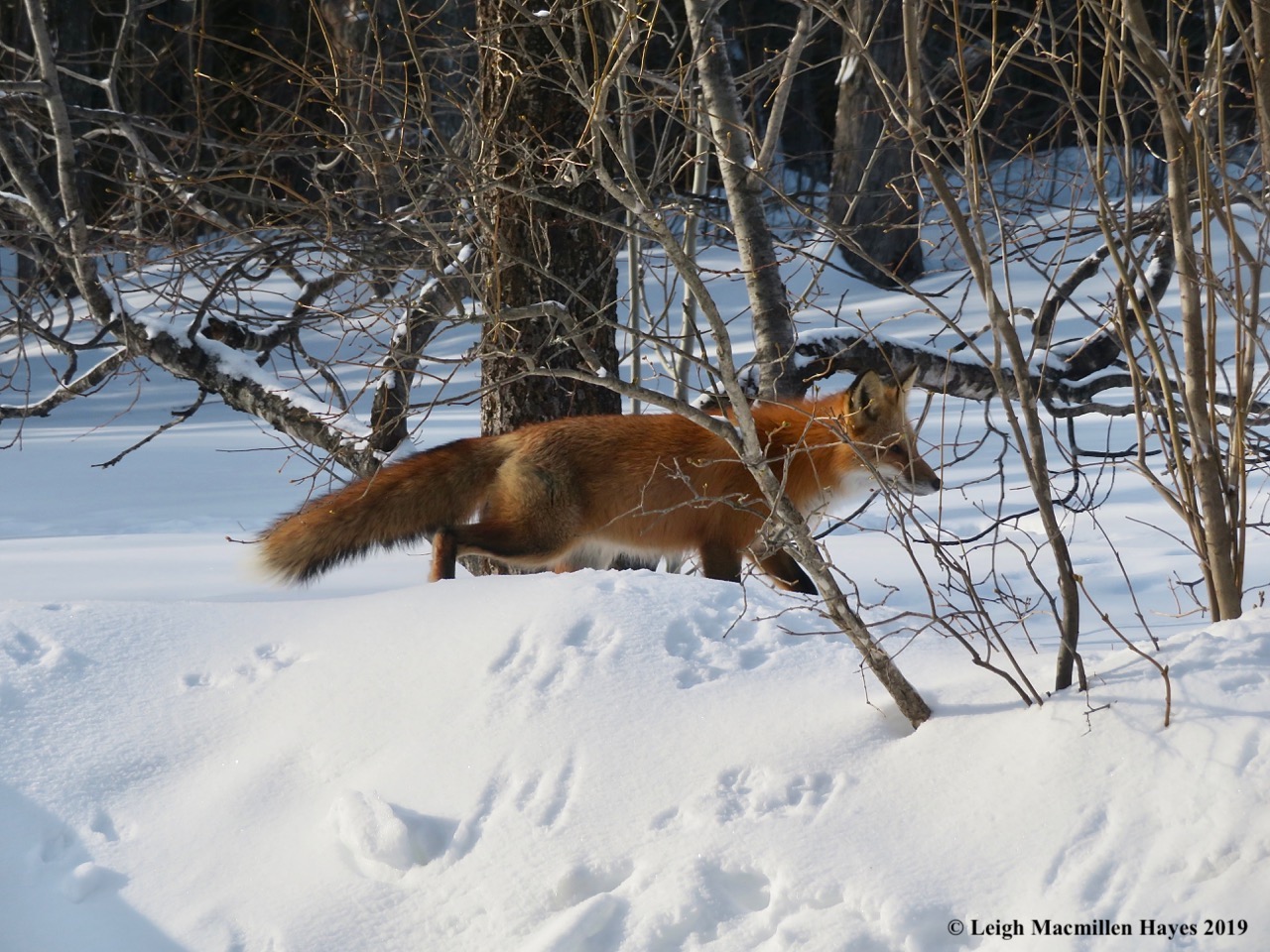
He was on the prowl. Do you see all the gray and red squirrel tracks on the snow? And Mary’s comment that foxes will hunt during the day in the winter. One would think that given all the squirrels and mice folks were dealing with last fall, a result of the previous year’s mast crop production of acorns, pinecones, and beechnuts, the foxes and coyotes and bobcats would have plenty to feast on. But . . . there wasn’t so much food for those little brown things to cache this winter and so it’s a rare occasion that I find a squirrel midden or even mouse tracks in the snow right now. Instead, they are all at my bird feeding station. And my daily fox knows this. Though I haven’t seen him find success, he returns repeatedly and follows the same route each time so I suspect he’s helped himself to a few local delicacies.

Notice that long snout–the better to smell you with, my dear. Oh wait, that was the big bad wolf, not the big, bad fox.
Just after I shot this photograph, he pivoted and dashed off in the direction from whence he’d come.

And then he returned, with nothing dangling from his mouth. His eyes, in the front because he was born to hunt (eyes on the side, born to hide–like a deer), focused on something in the quaking aspen that I couldn’t quite see from my vantage point.

He went back to the tree and for a second I thought he was going to climb it. Hmmm, gray foxes climb trees, not red.
Again, this was from the edge of the door and I couldn’t quite see what had captured his attention. Prior to his visit, the feeders and ground had been a party spot for a slew of squirrels and birds. I doubted a bird would hang out in a tree while a fox lurked below, but wondered if a squirrel was trying its darnedest to blend in with the tree trunk. And if it was a red squirrel, it was keeping its mouth shut for a change for I heard not a bit of its usual chatter.

After a minute or two, Fred, as I’ll call him (after all, Mary named her fox) moved a few feet away, sat down and began to scratch behind his ear. Those darn fleas.

He sat there for a few minutes and then got up and began to walk away. But his eyes . . . still they were focused on that tree.

At last he gave up on that particular quarry and ran off, following his usual route across the yard toward the neighbor’s house. I wonder how many cats they have left.

I gave Fred a wee bit of time to move on so I wouldn’t disturb him and then I headed out because, after all, who can resist the opportunity to check out brand, spanking fresh tracks? Remember that red fox’s feet are quite hairy so their prints look rather muffled, even in the fresh dusting of snow that fell overnight.

Do you see the X between toes and pad? Some semblance of nails? And can’t you just envision him loping across the yard?

Remember how he sat down to scratch behind his right ear (looking head on it would have been his left to us)? Well, I found the spot where he’d left an impression on the snow. And more. A tad of pee and SCAT! He’d dined on something.

I backtracked him for a while, crossing over stonewalls and into neighboring tree lots curious about where he comes from, but as Mary Holland reminded me, “As the weather turns cold, Ferdinand and his siblings sleep outside on the ground and no longer use their den.” Instead, they curl up and their bushy tails keep them warm. At last, I came to a tree where he’d dillydallied.
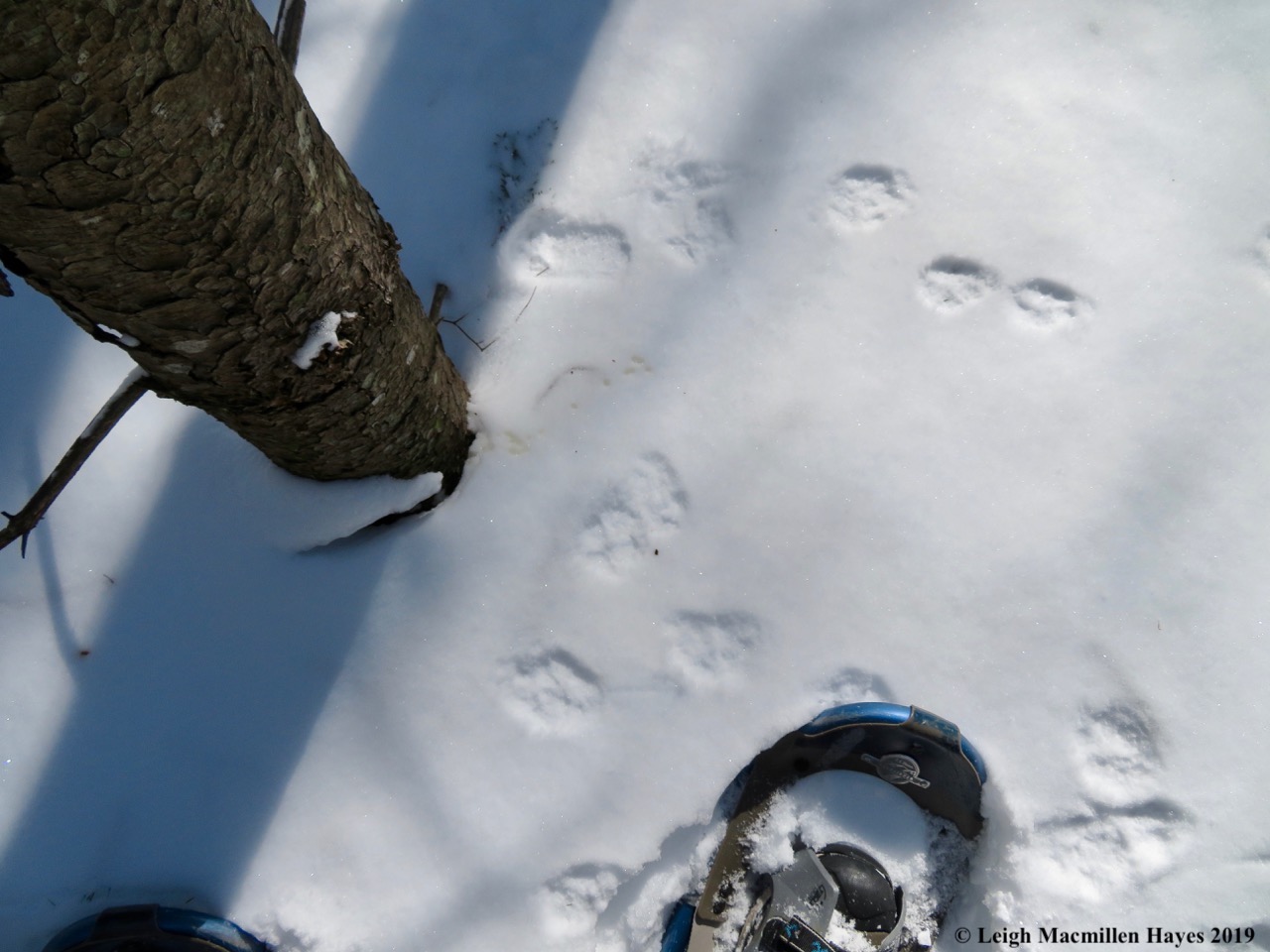
And then I spied a tiny amount of yellow snow–he’d tinkled (what fun to write “tinkled”) there. The sniff test results: skunky scent. Has he not mated yet? One day more than a month ago he did bring a gal by, but I haven’t seen her since. Red foxes typically breed in January and February, and it is, after all, still February for a few more hours.

At the end of our cowpath, he’d turned south as he always does and his track became but a memory.

Mary’s book can help keep that memory alive. It’s only one of numerous children’s books she’s now written. All have cross-curriculum teaching activity guides that one can download from www.SylvanDellPublishing.com.
Mary is also the author of Naturally Curious, which is now out of print (though someone told me there is an updated edition, but I’m not sure its been published yet), and Naturally Curious Day-by-Day, and she shares a blog post about five times a week with those who wish to learn more.
I’ve had the honor of being in her presence twice, both times here in western Maine, and she is delightful, down-to-earth, and extremely gifted as a naturalist, photographer and author. She’s also quite approachable and I’m always amazed that she takes the time to answer questions via e-mail.
If you follow her blog or read her books, you’ll feel as if she’s either walking beside you or just ahead. Mary, if your ears are burning, it’s because those of us who do follow in your tracks often comment on the fact that what we see you just happened to post. Thank you for helping all of us, no matter our age, become naturally curious.
Once again, the February Book of the Month: Ferdinand Fox’s First Summer.
Ferdinand Fox’s First Summer by Mary Holland, Sylvan Dell Publishing, 2013.
Foggy Moments
One day it’s -8˚ and a couple of days later the thermometer reads 50˚–our New England weather about as fickle as those of us who inhabit this space. Today was one of those high temp days and as I stepped outside, the air offered a weighty feel.

On a fluid roam with no apparent destination, but rather a strong inclination to be outside, my snowshoes sunk indicating that the snow pack is still significant despite recent rain.
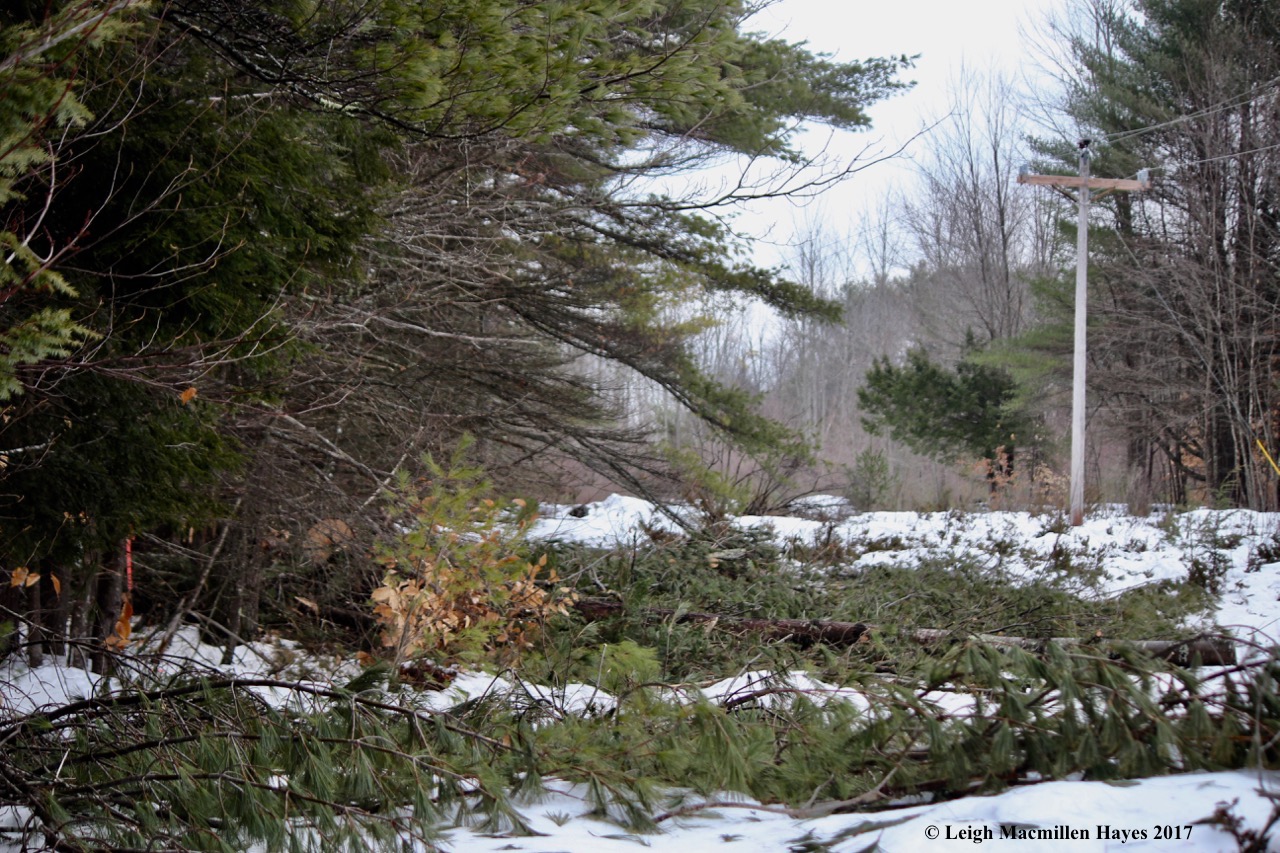
I trekked out by the power line, where Lucas Tree Service had indeed completed an intended cut on neighboring land. Though I’m glad that the mighty hackers left the downed trees behind where they can decompose and replenish the earth, I’m still not certain why they needed to cut in this area. The trees were all healthy and even if wind toppled one, it wouldn’t fall toward the lines, which are due west–this is more of a north/south tunnel. I also don’t understand their need to drive all over the snow-covered vegetation located below the lines, though I do know that their mission is not to embrace what grows there. OK, enough of my rant.

While I’d saved some trees on our land from being hacked, there were others that no amount of hugging would protect. One of the most beautiful hemlocks, which had been checked upon repeatedly in the past few weeks, finally became the focus of Mr. Porcupine‘s works. He’s living under our barn at the moment and doesn’t have far to travel to reach this future Lorax tree.

Unlike Porky, I had no idea where I wanted to explore but decided a visit to the vernal pool would be a perfect place to begin. If I didn’t know better, I’d have thought it was a March day, given the slushy surface of the frog pond.

Raindrops began to fall and rippled across puddles formed atop the ice. While I enjoyed the spiraling collisions, I failed to see a visitor on the beech leaf until I looked at the photo. Who it was shall forever remain a mystery.

There are lots of mysteries in these woods–thank goodness. Occasionally, as happened today, I come upon the shell of hickory nut which I presume was gnawed by a gray squirrel. Perhaps someday I’ll stumble upon the tree and know the source. I have an idea it may actually grow around the corner from us and maybe others have taken root–another mission for another day.

For today, I had no mission except to wonder as I wandered. I wondered where the snowshoe hare hid while I sloshed about for though I couldn’t quite see its tracks due to the current conditions, I knew it had been eating here, there and everywhere.

I wondered about the tenacity of the red oak that stood beside the stonewall as a youngster when this land was still farmed. And with that came a wonder about family and friends who are displaying equal tenacity to overcome barbs in their lives.
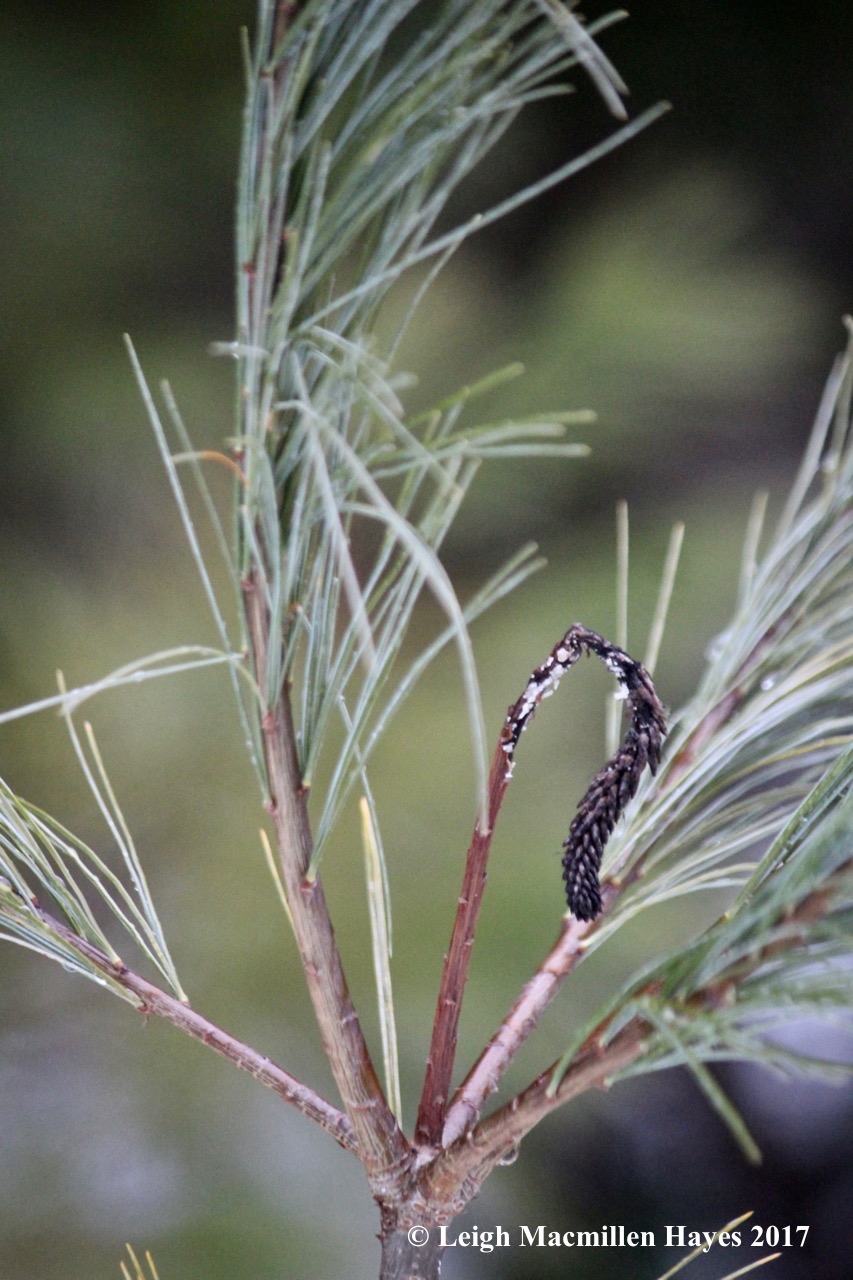
I wondered about the weevil that choose this particular pine among so many to attack. And again my thoughts wandered to my community of family and friends.

And finally, I wondered some more about the natural community that surrounded me and all that it has in store to teach me. It’s in varying stages of succession from the spirea, bulrushes and blackberries,

to young red maples and gray birches,

middle-age gray birches
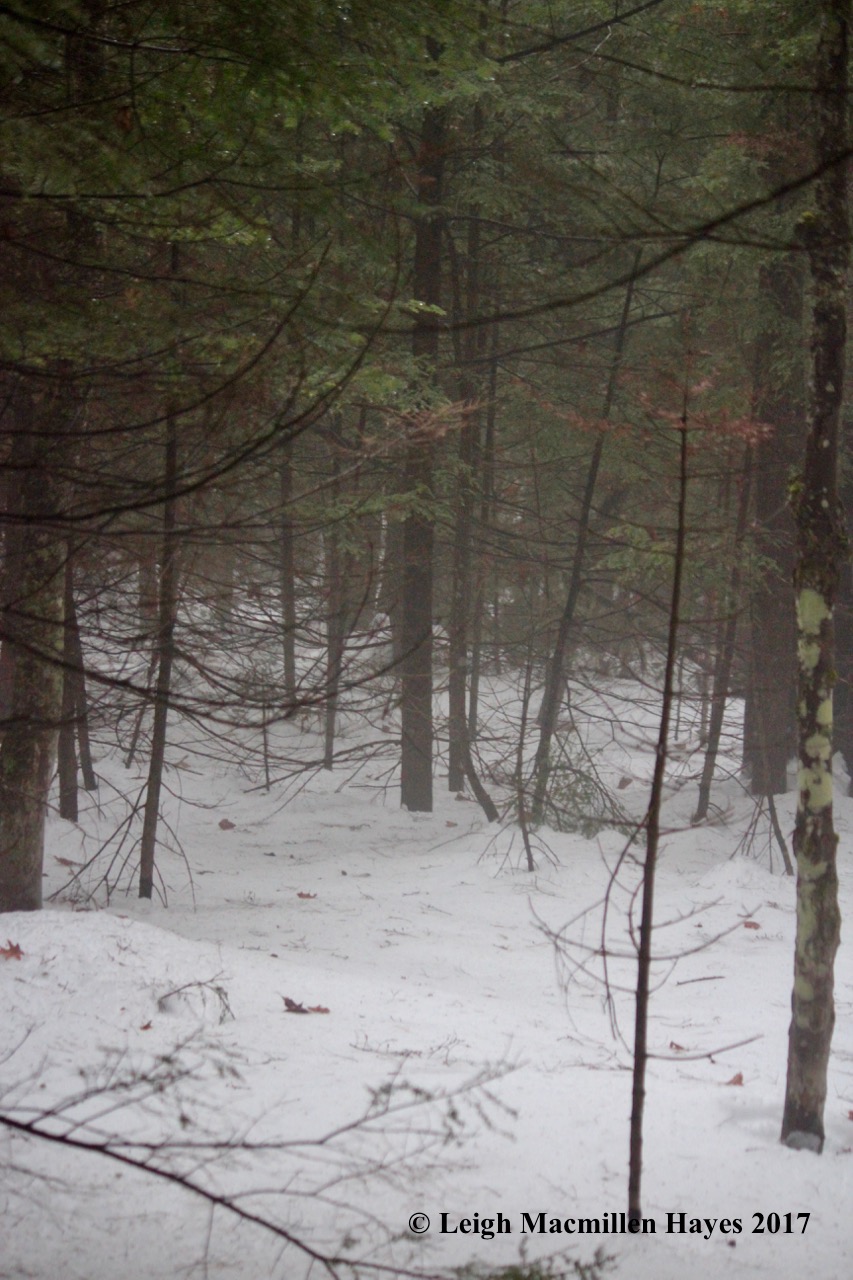
and a variety of evergreens. What once was all farmland grew into a forest, which invited a variety of mammals to make this place their own, and in turn invited loggers to make the trees their own, and in turn invited the flora and fauna to return. I can’t control it all and that’s probably a good thing.

What I could control was my opportunity to wander. At the end of the day, I headed in, a bit damp, but happy for a foggy meander, hopeful for others, and grateful that I get to call this place home.
Everybody Loves Raymond? Mondate
My guy and I were up for an adventure this morning as we headed off to a property recently acquired by Loon Echo Land Trust. I’d been there once before, but at that time there was no trail system and I certainly hadn’t climbed to the summit.

We were on a 356-acre property bisected by a paved road. First, we hiked the upper section, passing through a hardwood forest.
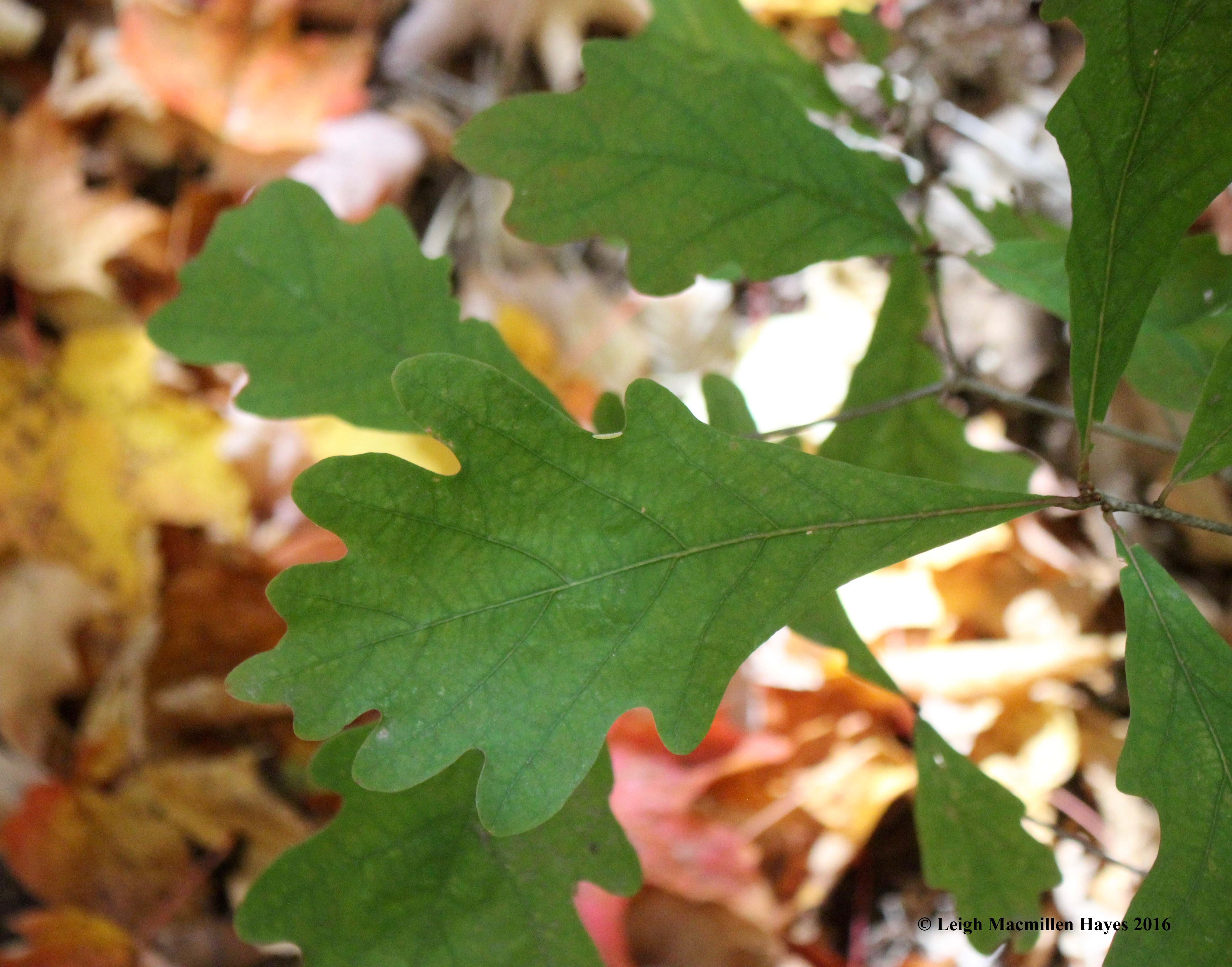
Immediately, I realized we were in the presence of one of my favorites–noted for the mitten-ish presentation of its leaves. One would have to be all thumbs to fit into this mitten, but still, my heart hums whenever I spy a white oak.

Or in this case, many white oaks, some exhibiting the wine color of their fall foliage.

And the bark–a blocky look that differs greatly . . .
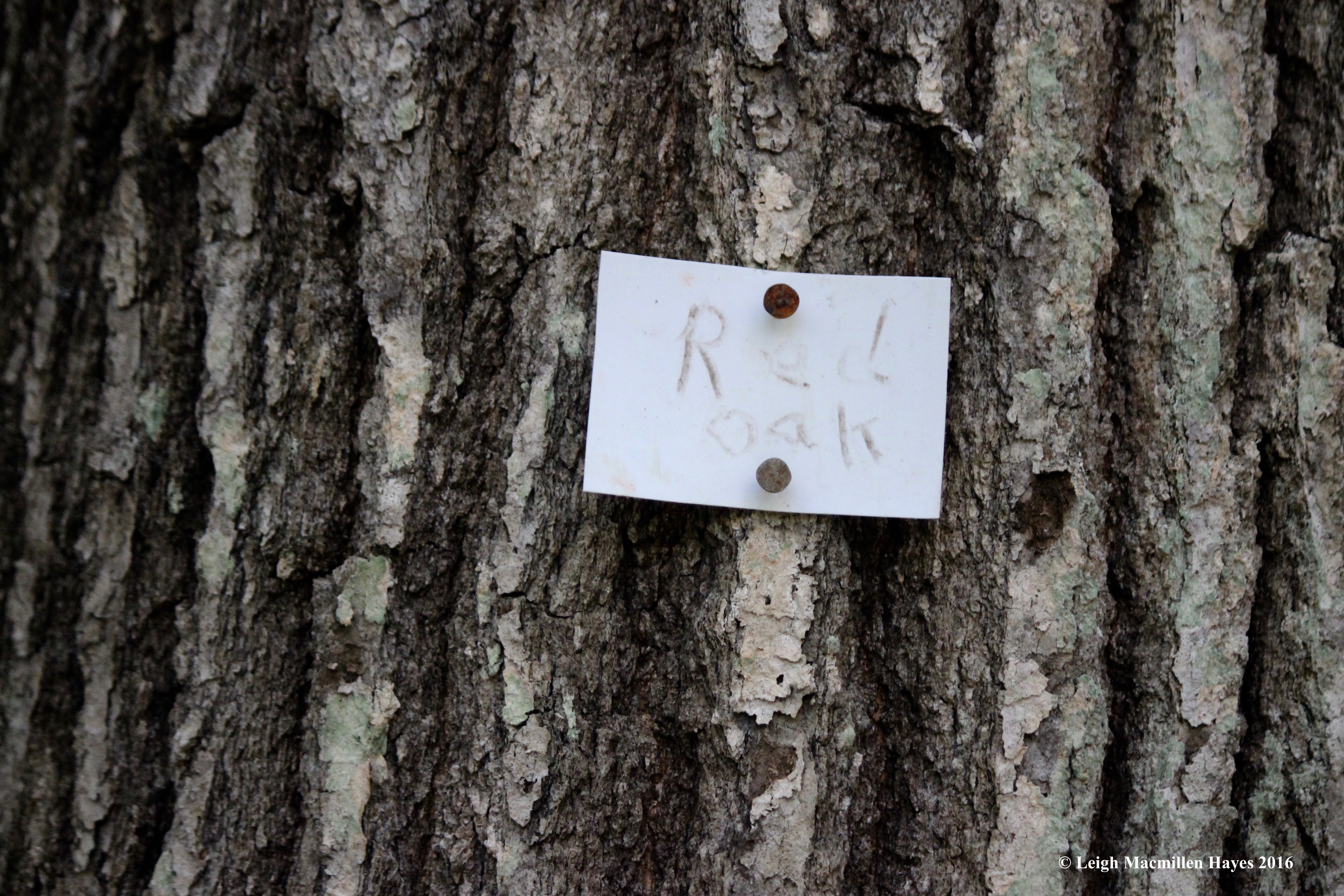
from the ski trail ridges of red oak.

Hop Hornbeam also grows abundantly in this forest.

As we neared the summit, we noticed that the sky view had a yellowish tone reflected by the ground view. Most trees were of the same age due to past logging efforts, but the predominant species was sugar maple.

Another favorite tree also grew abundantly here. I think they are also favorites because I don’t see them as often. In this case, the bark, though furrowed and ridged like a northern red oak, featured an almost combed flattened ridge.

And its leaves–oh my! Notice the asymmetrical base? And the length–my boot is size 8. American basswood–an important timber tree that is known to share the community with sugar maples and hornbeams–all of which provided that yellow glow.

At last, we reached the vantage point.

Above us, a mix of colors and species.

Before us, a mix of white and red oak leaves.

And beyond us, the view of Crescent Lake

and Rattlesnake Mountain.

While we admired the view, ladybird beetles (aka ladybugs) swarmed us. Well, not exactly in swarm formation, but more than is the norm.

After admiring the view for a while and wondering about the ladybirds, we backtracked a bit and decided to explore the green trail, assuming that it looped about the summit.

The trail conditions changed constantly, and one thing we realized was that the leaves had dried out and we wished we could have bottled their scent along with our crispy footfall as we trudged through–the smells and sounds associated with autumn.

Eventually, we entered a beech commune and what to my wondering eyes should appear–bear claw marks? We ventured closer, circled the tree and looked at others in the neighborhood before determining that our eyes had perhaps played a trick on us.

That was OK because within seconds a twig moved at our feet.
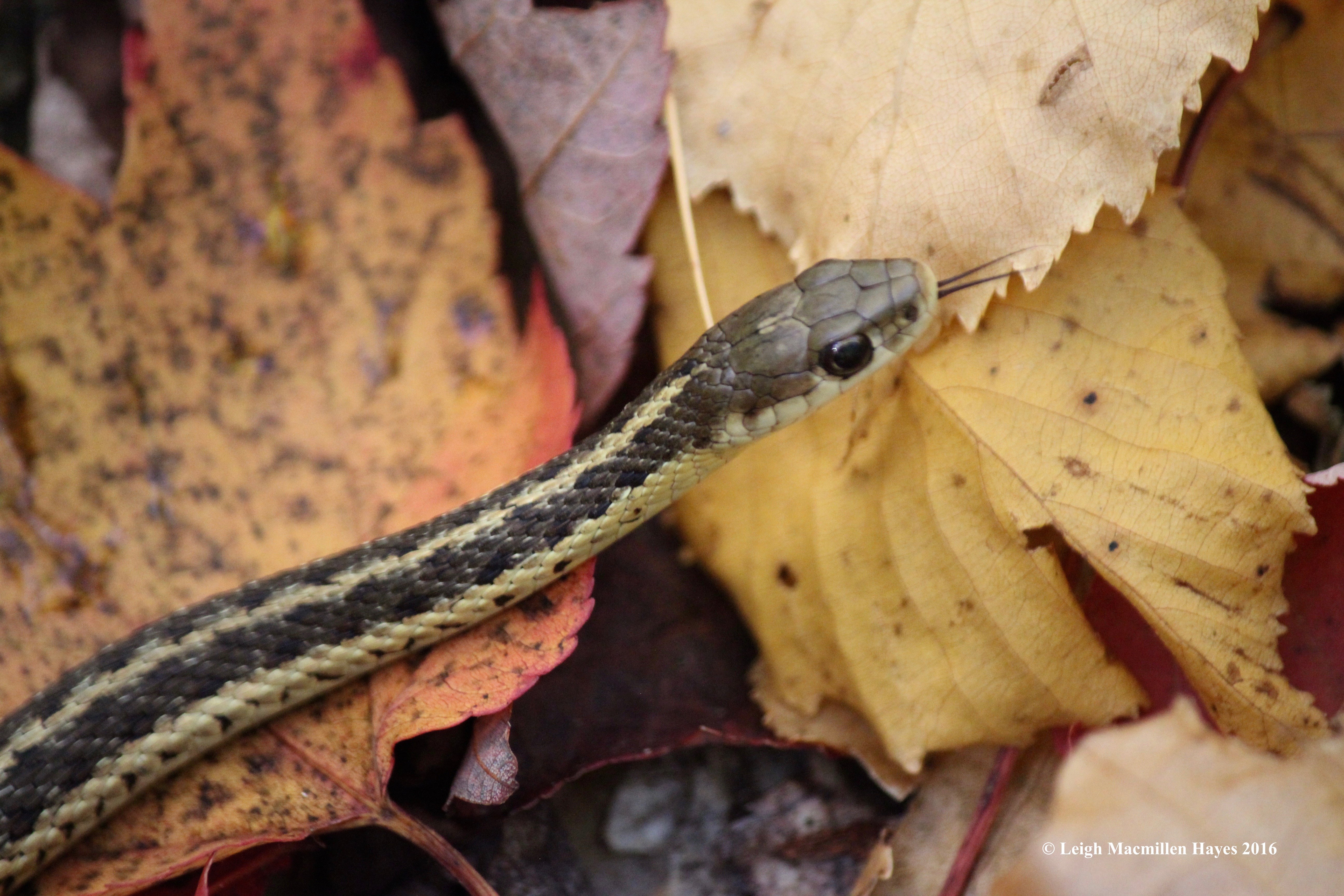
We watched as its tongue darted in and out, red tipped with a black fork.

Finally, we moved back to what we’d named Ladybird Lookout and found lunch rock where we topped off sandwiches with Bailey’s Irish Cream fudge a la Megan and Becky Colby. Life is good. Life is very good. (And we know a town in western Maine that would benefit greatly from a bakery–just saying, Megan!)

After lunch, we climbed back down and crossed Conesca Road to check out trails on the other side. There is no trail map just yet, but we never got lost. And we appreciated the artwork nature created of manmade marks.

This space offered a different feel where hardwoods combined with softwoods. And more stonewalls crossed the property, speaking to past uses.

It’s here that we noticed an area demarked by pink flags and stopped to wonder why. Note to self–excavated hole and debris mean beware.

Upon closer examination, an old hive. So who dug it up? We had our suspicions.

We also noticed a fungi phenomena.

Fungi on fungi? Honey mushrooms attacked by something else?

The displays were large

and otherworldly. I don’t recall ever seeing this before.
I sent the photos to Parker and Jimmie Veitch, of White Mountain Mushrooms, and Jimmie responded with this explanation:
“That’s what mycologists call “rosecomb” mutation, where a mushroom’s gills start forming on the cap in a really mutated fashion. It’s been reported in many mushroom species but I haven’t seen it in this one (Armillaria AKA honey mushrooms). As far as I know, no secondary fungus is involved.
The suspected cause (not so nice) is ‘hydrocarbons, phenols and other compounds contaminating the casing or contacting the mushroom surface. Diesel oil, exhaust from engines, and petroleum-based pesticides are thought to be the principal source.'”

As we concluded our visit, we passed over one more stone wall decorated with red maple leaves.
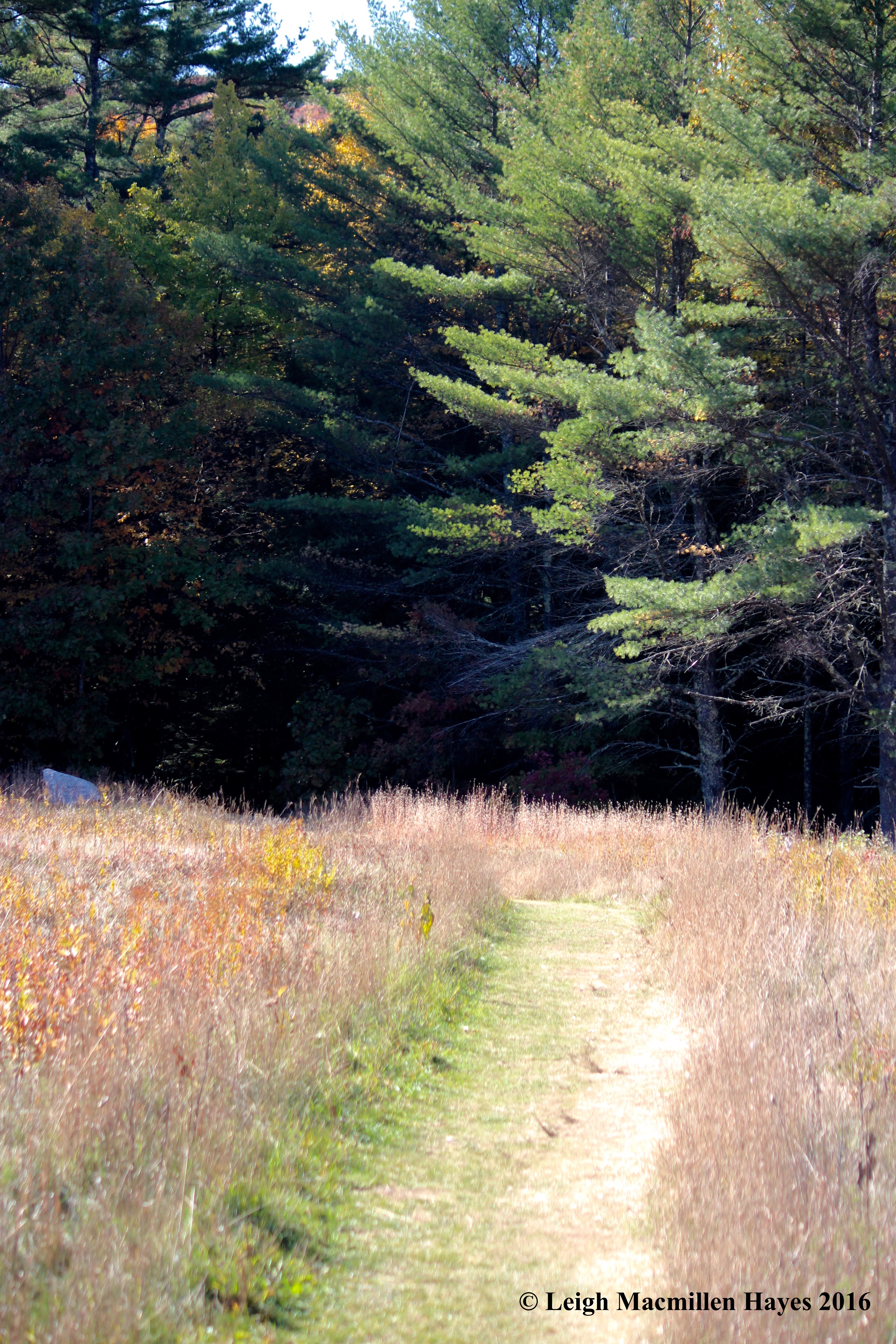
And then we hopped into the truck and traveled a couple of miles south to conquer another small mountain–one visible to us from Ladybird Lookout. (I really think LELT should name it such.)
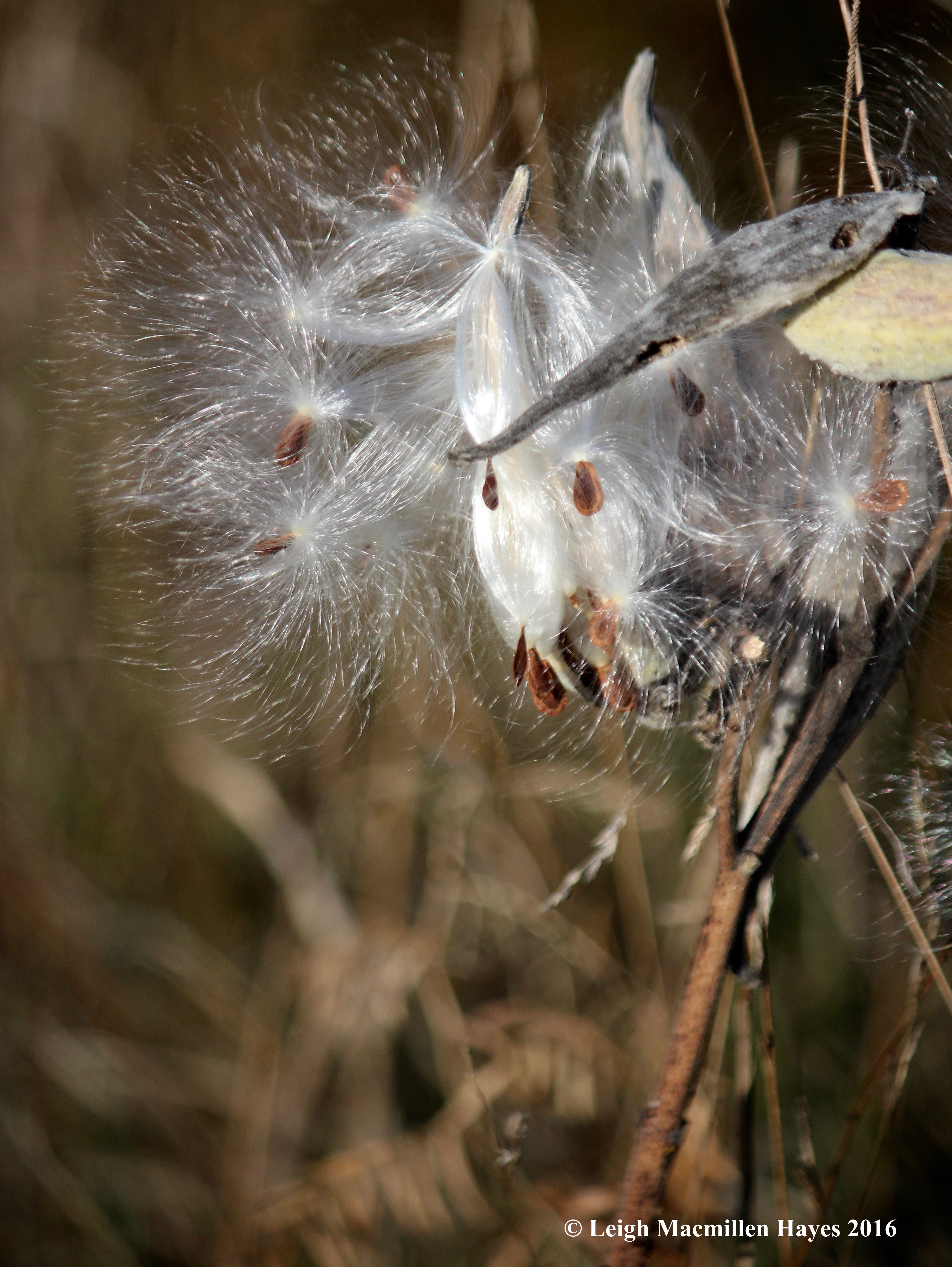
Here the milkweed plants grew abundantly.

In the field leading to the trail, the property owners planted white oak saplings in hopes of providing food for wildlife. Um, by the same token, they’d enclosed the saplings in plastic sleeves (reminding us of our findings in Ireland) to keep deer at bay.

The understory differed and ferns offered their own autumn hues.

In contrast were the many examples of evergreen wood ferns.
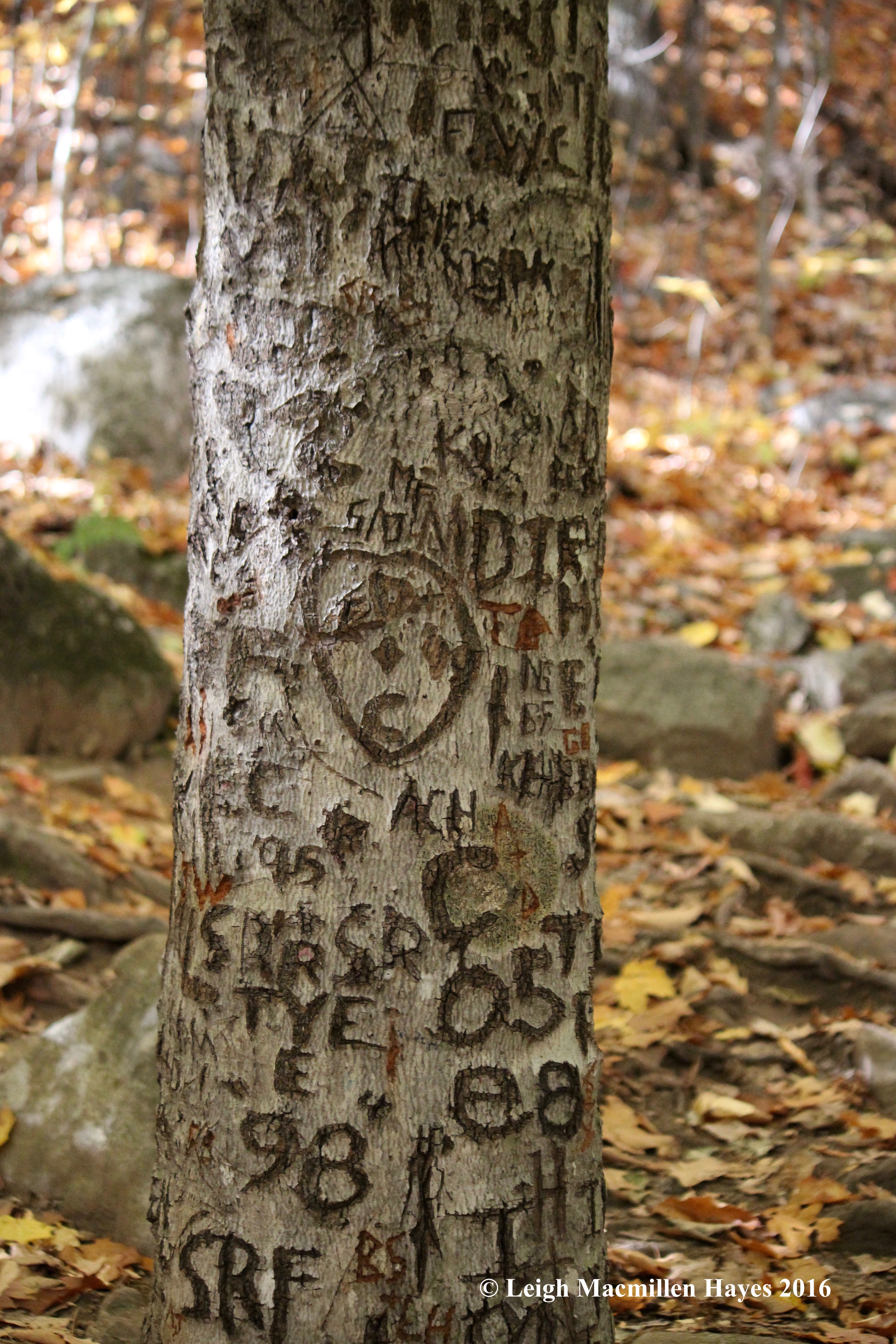
We soon realized that quite literate bears frequented this path and announced their presence.
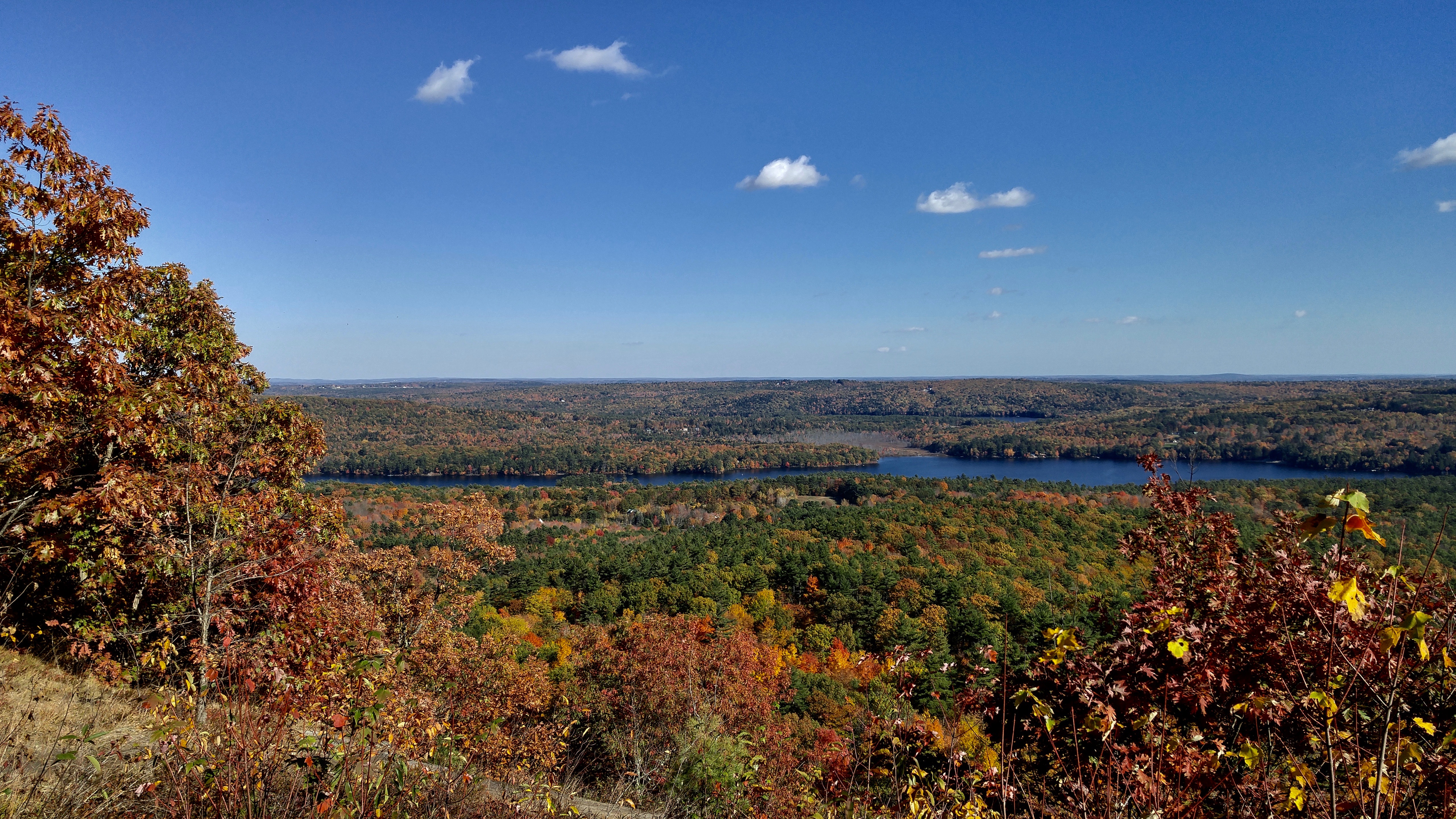
At last, the view opened and we looked back at the opposite shore of Crescent Lake, though realizing that our earlier ascent was masked by the trees.

Turning about, Panther Pond came into view.
We’d spent the day embracing Raymond because everybody loves Raymond.


Raymond, Maine, that is. Loon Echo Land Trust is gearing up to celebrate the Raymond Community Forest that we explored this morning and the Bri-Mar Trail up Rattlesnake Mountain has long been traveled by many. In fact, when I used to write copy for the local chamber of commerce, I spent some time learning about Edgar Welch, who was the fastest man on foot and ran up Mount Washington at least once a year. He lived in Raymond and worked for David McLellan, who was partially blind from a Civil War injury. Because Mr. McLellan’s farm was at the foot of Rattlesnake Mountain, the sun would set one hour earlier than elsewhere in town. According to legend, after work each day Edgar ran up the mountain and moved rocks. Finally, he’d moved enough to let the sun shine on the farm for an hour longer. Another story has it that one day a man bet Edgar that he could beat him in a race to Portland. The man would race with his horse and buggy, while Edgar ran. When the opponent pulled into the city, Edgar was waiting for him. I love local lore.
And everybody loves Raymond. Well, my guy and I certainly gained a better appreciation for this town today.
In Constant Flux
Ever so slowly, the world around us changes.

Sometimes it’s as obvious as the leaves that fall.

And other times, it’s a bit more subtle, evidenced by the bees that have slowed their frantic pace as they make final collections.
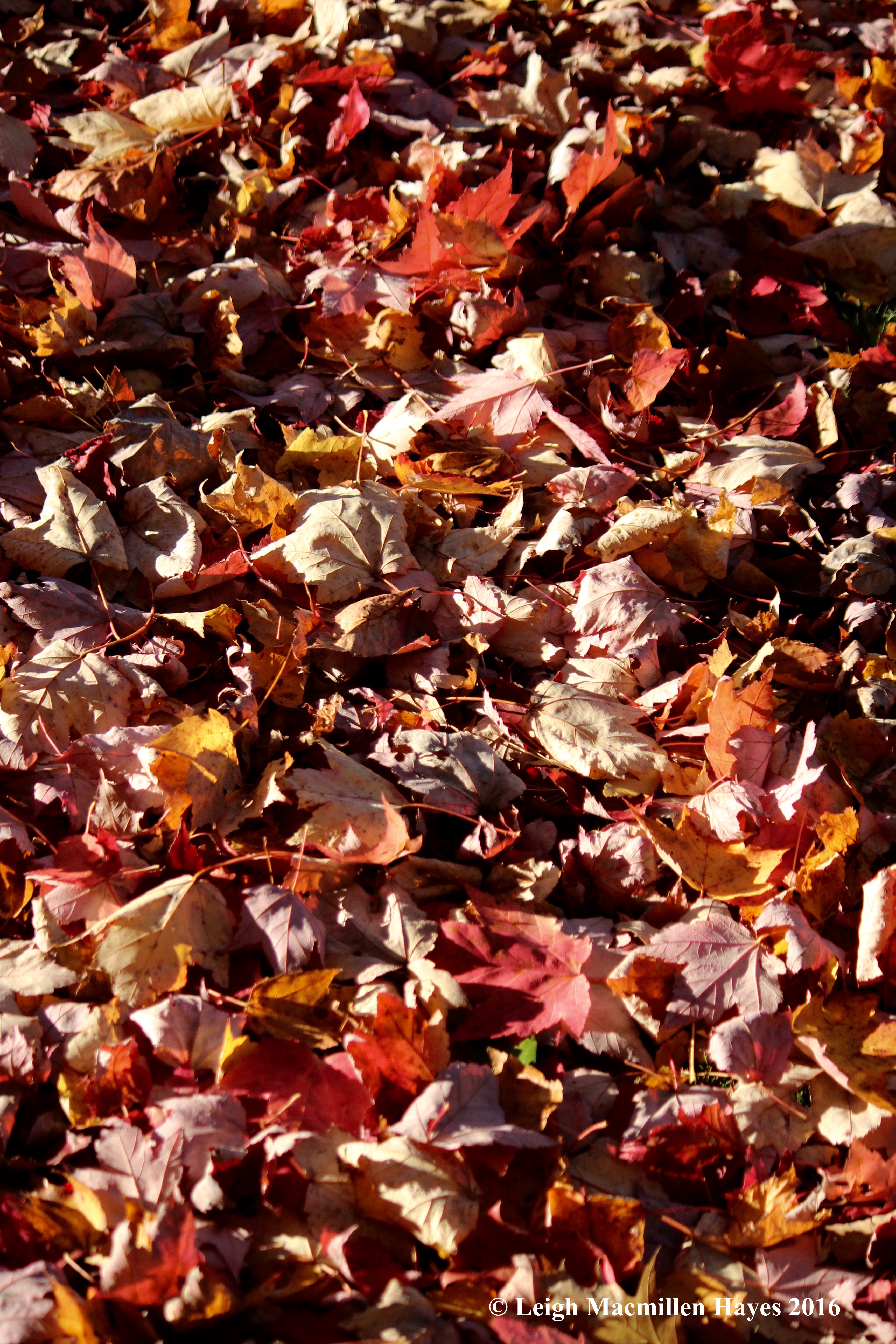
Mid morning, I headed down the cow path in search of other signs of change.
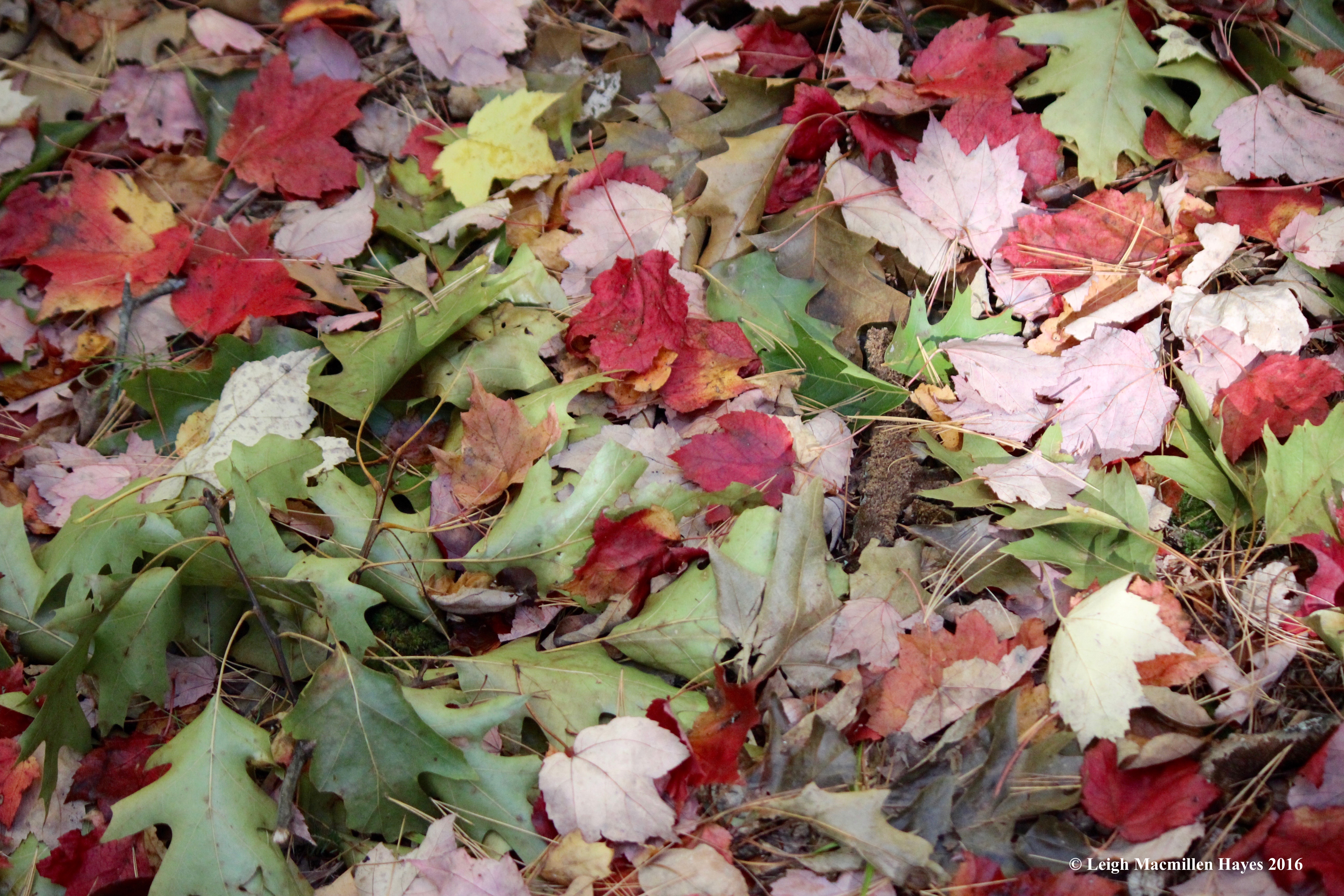
As I walked along, I began to realize the interdependence of all. Under the northern red oaks–many chopped off twigs.
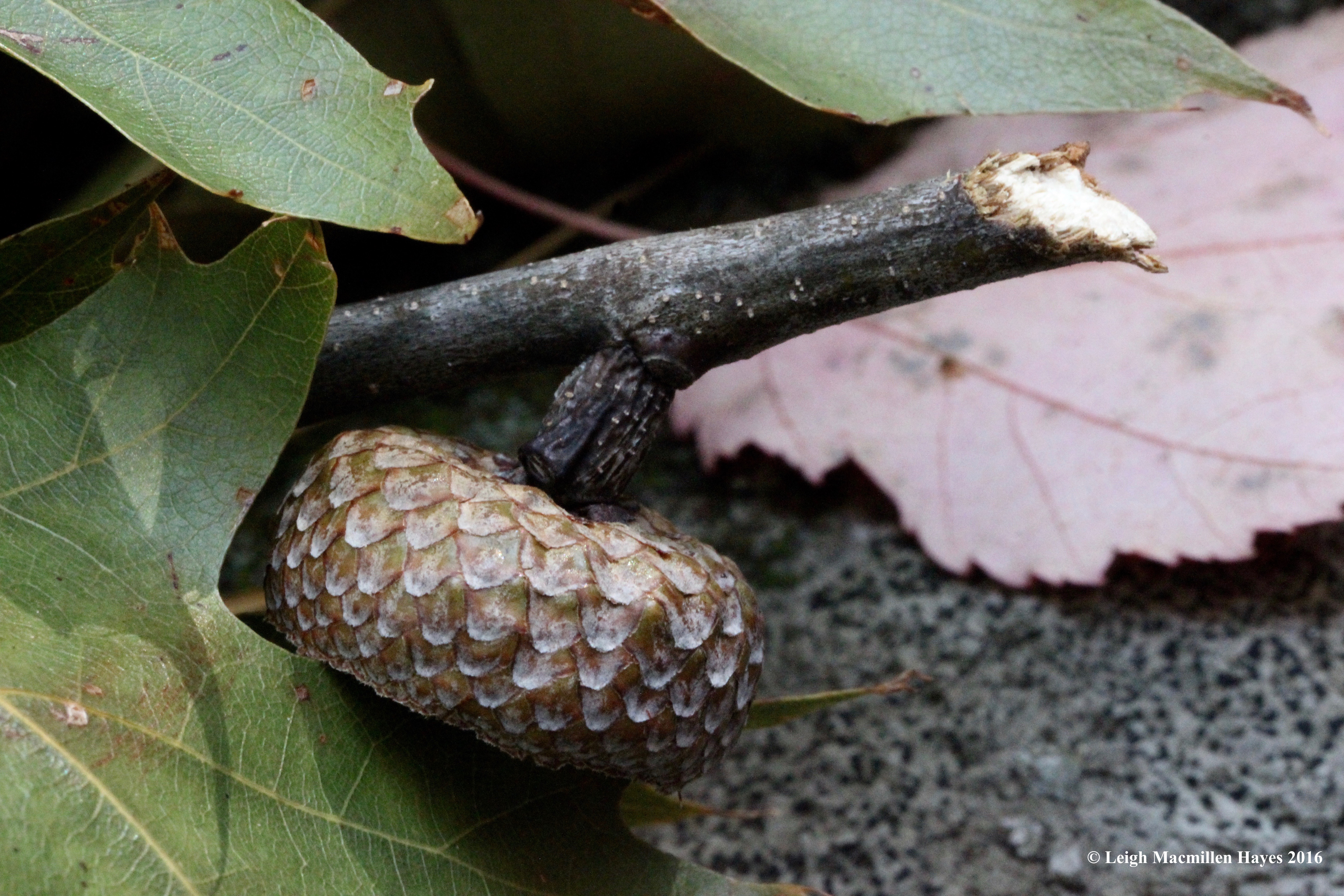
The angled cut and empty cap indicated the work of porcupines seeking acorns.

I found maple leaves pausing on hemlocks,

pine needles decorating spruce trees,

and occasional puddles offering a rosy glow. Eventually, all of these leaves and needles will break down and give back.

I found life on a rock, where lichens began the story that was added to by mosses. The creation of soil was enhanced by a yearly supply of fallen leaves and needles gathered there. And then a seed germinated, possibly the result of an earlier squirrel feast.

I found orange peel and many other fungi aiding the process of decomposition so that all the fallen wood and leaves will eventually become part of the earthen floor.

I found a healthy stand of trees and ferns competing for sunlight in an area that had been heavily logged about ten years ago.
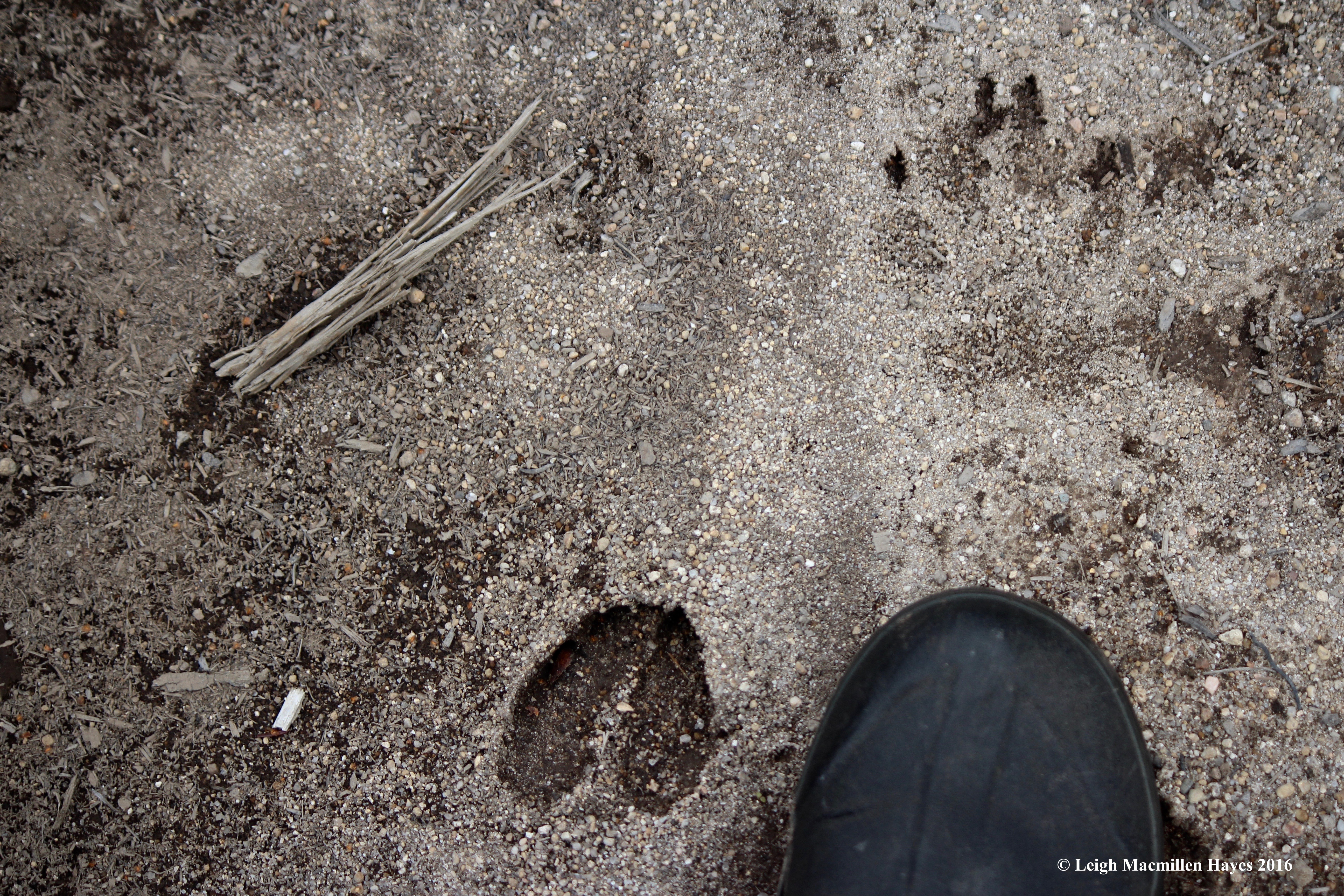
I found evidence of those who spend their lives eating and sleeping in this place.

I found seeds attached

and those on the fly–heading off in search of a new home.
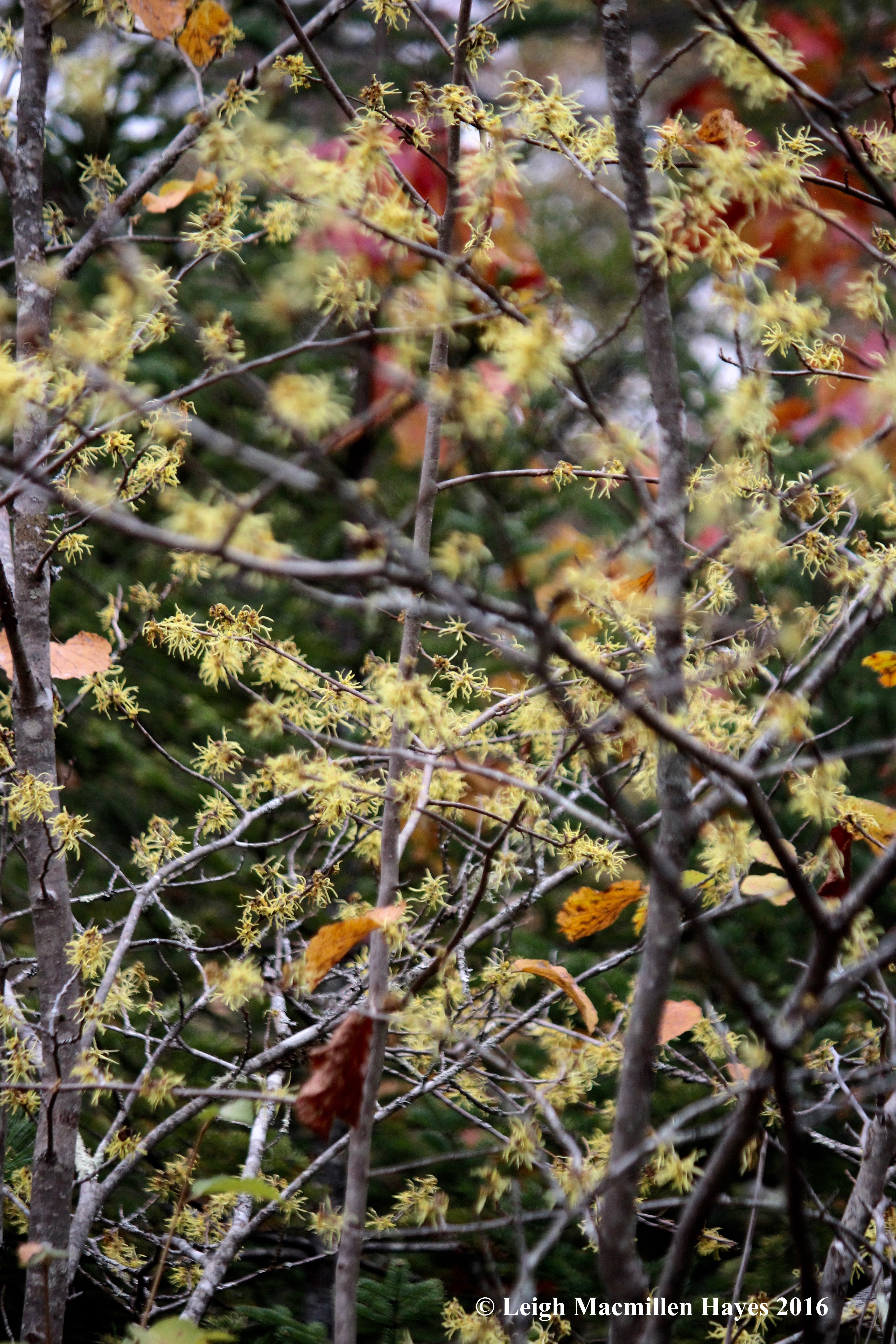
I found the last flowers of fall

exploding with ribbony blooms.
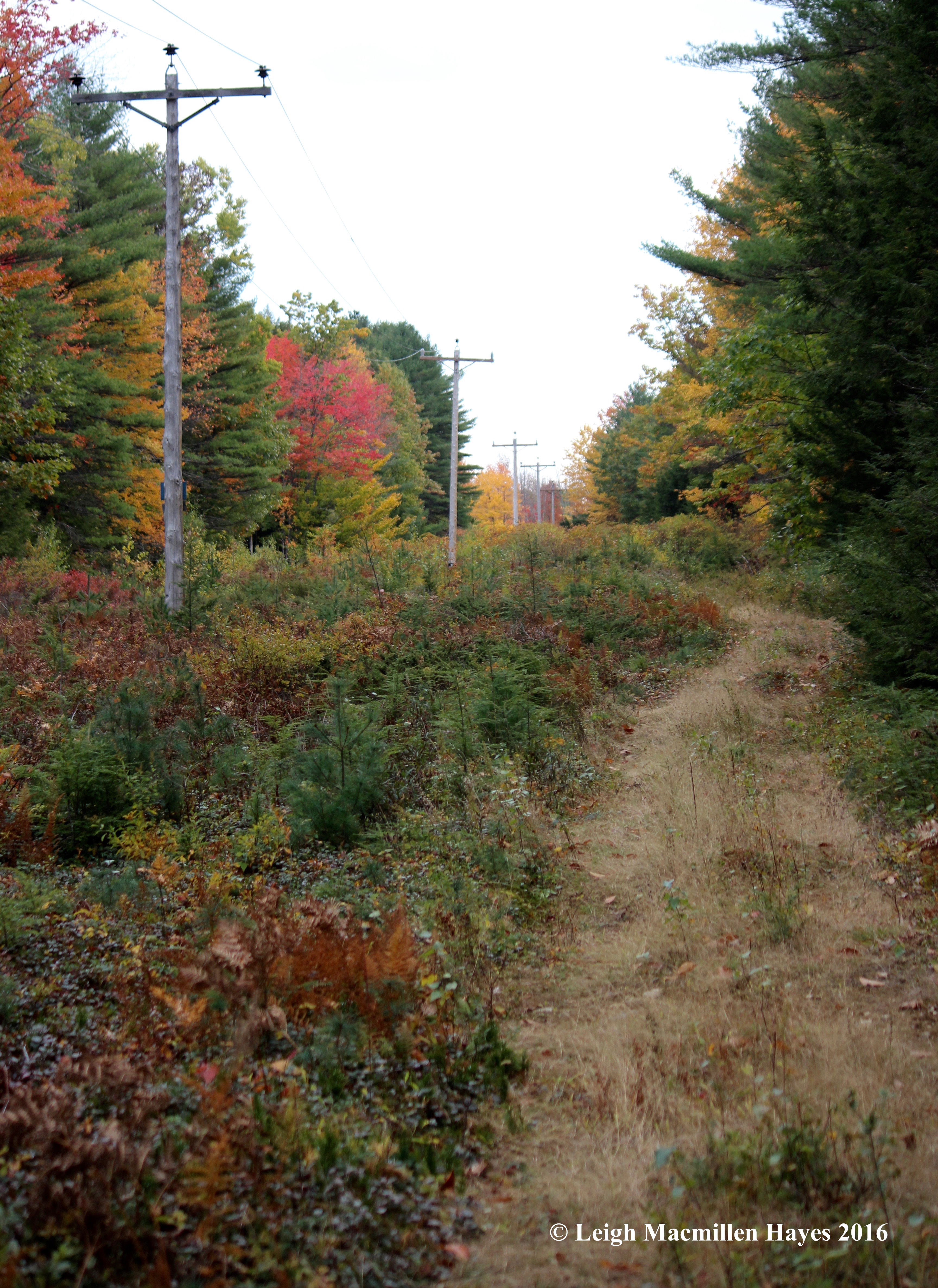
After bushwhacking for a few hours, I found the snowmobile trail, where man and nature have long co-existed.
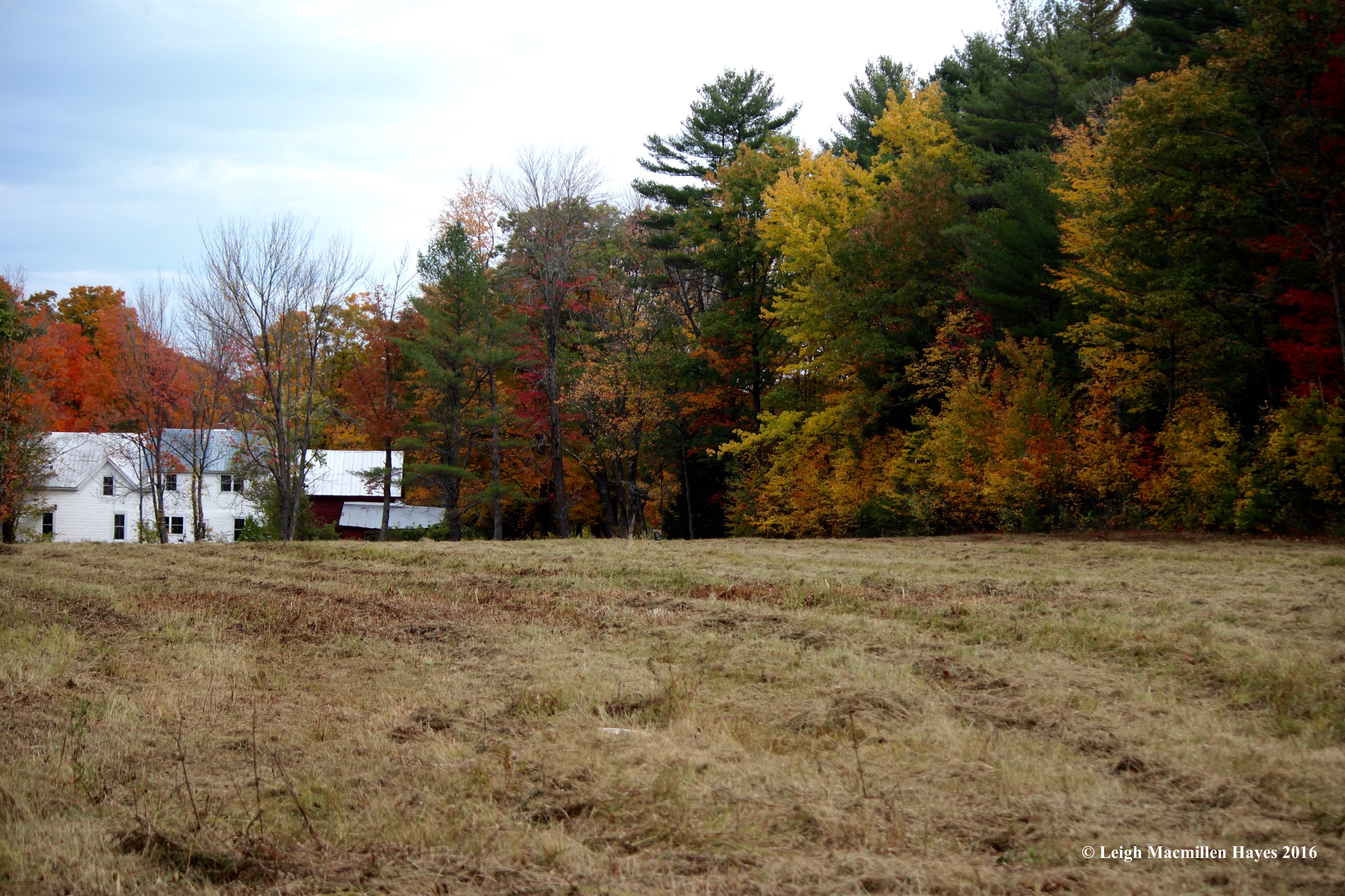
At last I found my way across the field rather than through our woodlot, thankful for the opportunity to take in the colors of the season one more time.
At the end of the day, I’m once again in awe as I think about how we, and all that we share this Earth with, are dependent upon each other and the abiotic forces that surround us.
And with that comes the realization that the scene is in constant flux and so am I.
What’s So Special About Bee Balm?
I have childhood memories of ugly red bee balm plants surrounding a maple tree in our front yard. In addition to being ugly, what really bothered me about this flower was the smell. The scent tickled my nose in an unpleasant manner and gave me an instant headache.

And then I grew up. Well, I suppose that’s questionable, but what did happen is I came to appreciate the showy flower and aromatic scent. (Funny thing is, an infusion of crushed, boiled bee balm flowers apparently treats headaches–I should have used it to treat the very symptom it caused. It has many other medicinal uses as well.)

This summer, like others, I waited in anticipation.

Even before it bloomed, its leafy bracts showcased a fluid beauty.

And those leaves set at right angles to the square stem offered a crossroads where color and texture met.

Finally . . .

with the aid of raindrops

and sunshine, the bracts pulled away and revealed star-capped tubes nestled within.

Ever so slowly, flowers began to emerge.

With a hat reminiscent of a jester, they crowned the plant.

Stamens projected from the tubular upper lip, while below, three slender lips provided a landing pad for visiting insects seeking nectar-filled sweetness.

Like me, the pollinators’ eyes shone brightly

as they sought

fulfillment.

I’ve spent many moments starring–in awe and wonder–at the structure, simple yet complex, and all of its idiosyncrasies.

And I know I’m not the only female who stops by to soak in the glory of this old-fashioned perennial.










What’s so special about bee balm? Everything.
P.S. This one is for you, Jinny Mae, because you, too, are special.
Wondering Among Giants
It’s not every day that I get to wander and wonder among 300-year-old giants, but such was the case today. A friend and I met at Robinson Woods in Cape Elizabeth. It was a reconnaissance mission for me as I’ll be leading a senior college class there next month. And for both of us, it was a delightful way to spend three hours snowshoeing on and off the trail, with frequent pauses to look, listen, touch, smell and learn.
Because the land was not suitable for farming (terrain rocky and uneven), it was left unchanged for all these years. Actually, we met the executive director of the Cape Elizabeth Land Trust along the way, and he told us that the Robinson family was a paper company family, but they left this piece untouched. Thanks go to them. And to the land trust for preserving the land so that it will remain in its natural state.
We could hear the birds sing and call as we moved along. Someone apparently wanted to make sure they have enough to eat as we found a couple of these “bird-seed” pine cones dangling from trees. (Separate note: back at home, for the second day in a row, I’ve had chickadees landing on my mitten to eat crushed peanuts–well, they don’t actually eat them on my hand, they just grab and fly to a nearby branch, where they use their feet to hold the nut or seed and then peck away at it.)
We followed this porcupine trail for a bit. As we backtracked our way toward the people trail, something caught our attention:
Yes, even in Cape Elizabeth, and only steps from the ocean, you can find bear claw sign on beech trees.
We showed these photos to the executive director of CELT–he had no idea they were there. I’ll be curious to see if he adds black bears to the list of mammals that frequent the property. I did see that they have pine martens on the list–that surprises me.
I know I’ve spent a lot of time writing about beech trees, but this one looks like a totem pole of gnarly faces. Think gargoyles. Was the beech scale disease initially responsible for this? I wonder.
Very gnarly indeed. In the center, you can see where a branch broke off.
This Red Maple had some serious burls. Perhaps they were caused by stress or injury, though researchers don’t know for sure why they occur. Despite the bumpy, warty growths, the tree appears to be healthy. You can see that there is new growth–young red branches sprouting from the burls. Removing a burl causes a large wound that could eventually harm the tree, so they’re best left alone–though I know woodworkers covet them.
We were almost back to our trucks when we came across this tree. It’s a young tree and we tried to key it out. We’re pretty sure it’s Shagbark Hickory, but if you know otherwise, please enlighten me.
Thanks for wondering along with me on today’s wander through the woods.


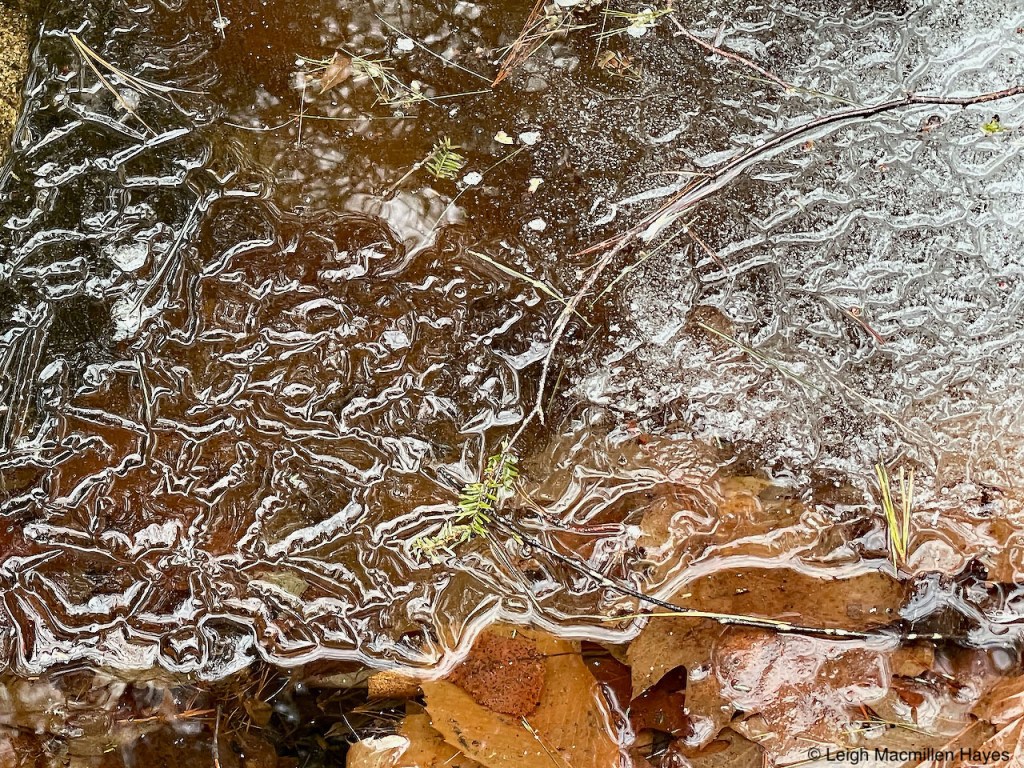

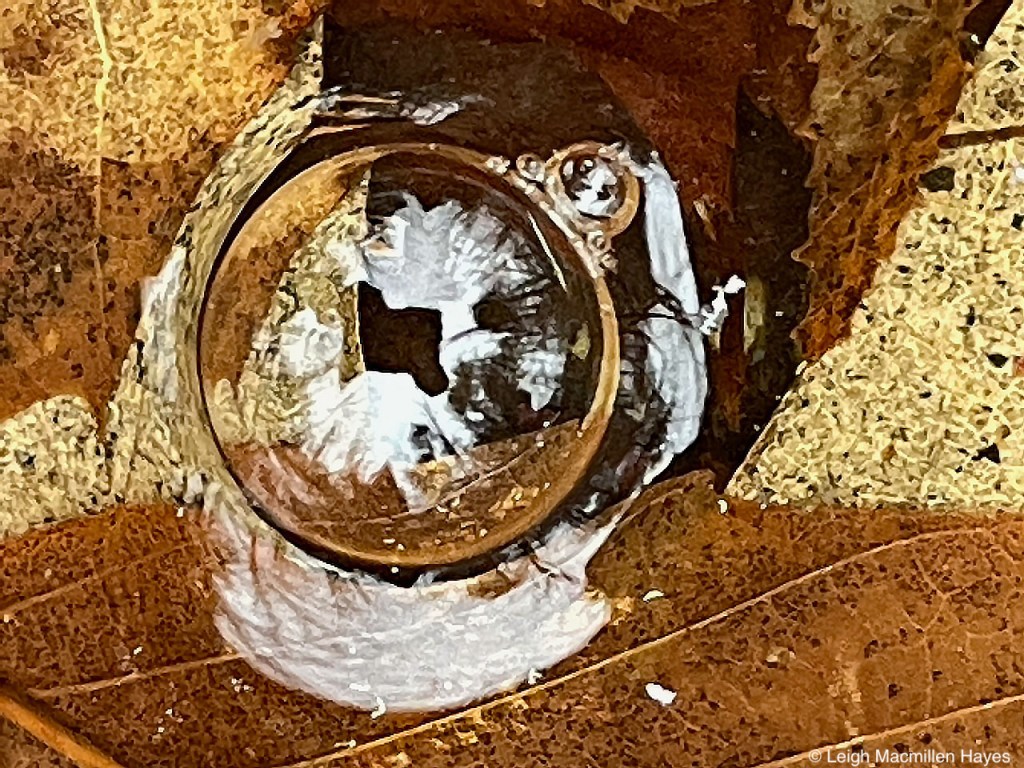
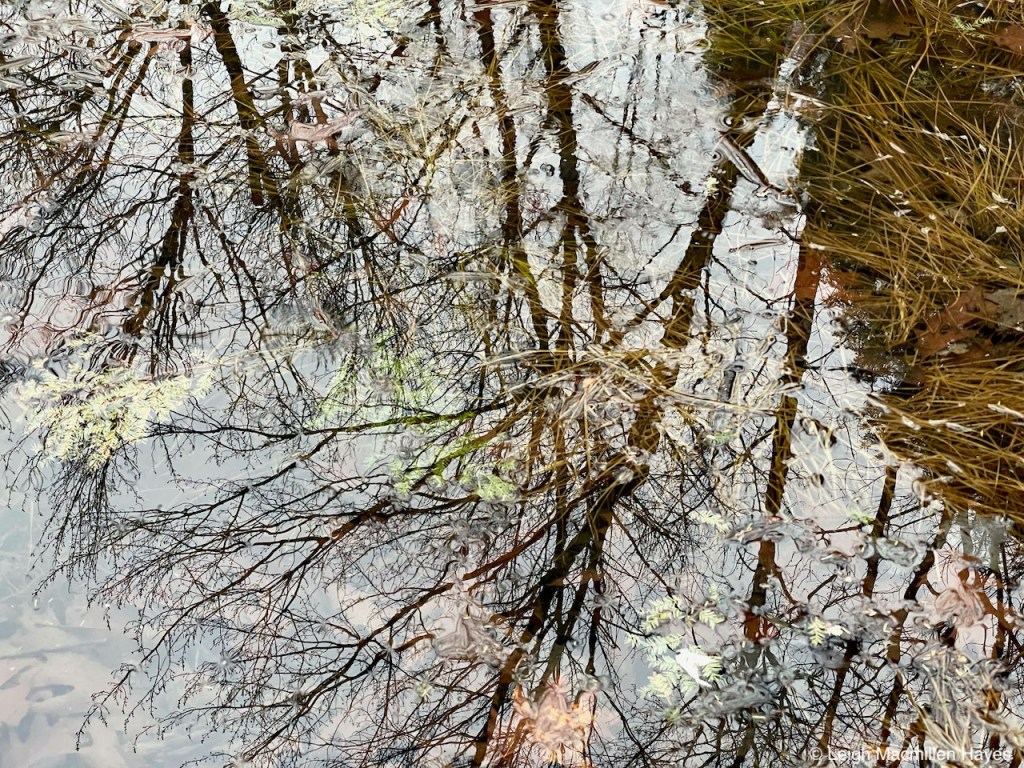





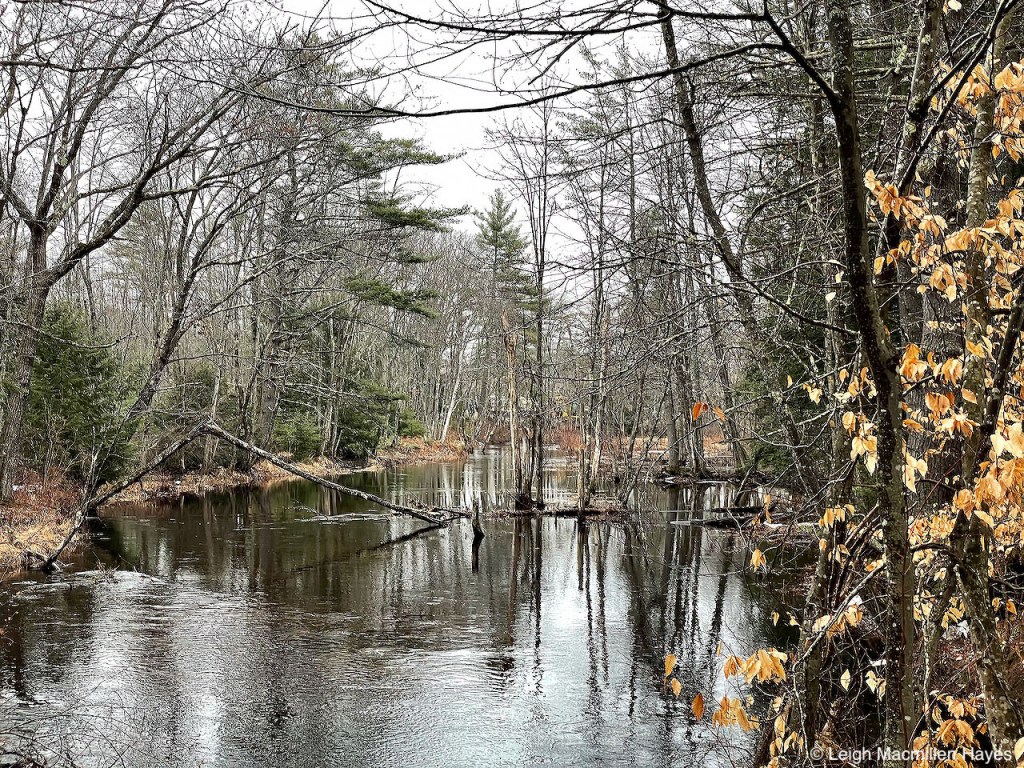

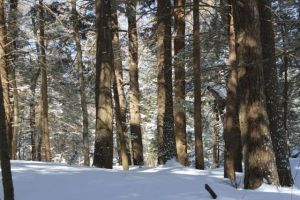
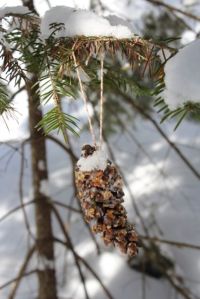




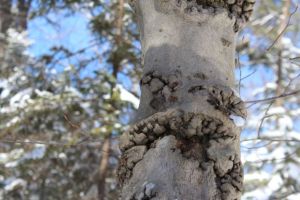


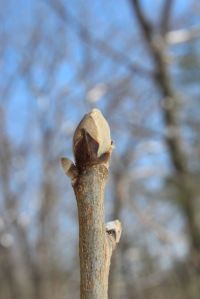
You must be logged in to post a comment.